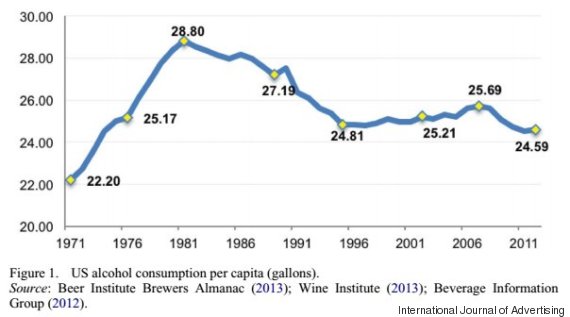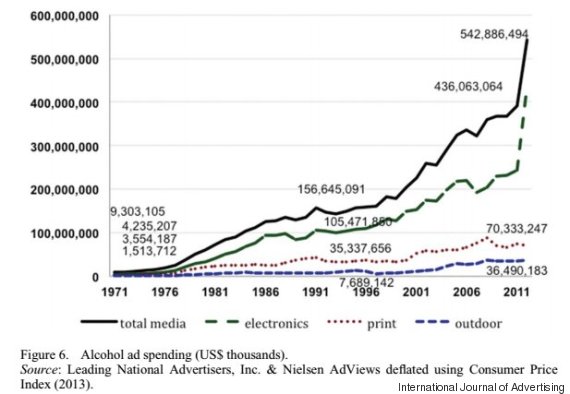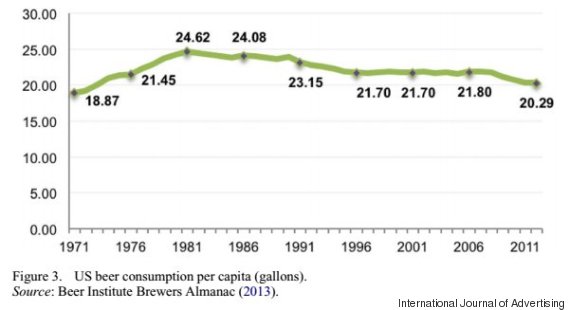Tuesday, March 31, 2015
Life. Life. Now!
This a talk from the Beyond Conference I gave in March, 2015 about living life in the present. I spoke about my weight loss journey and recovering from a seizure I had in October, 2014.
Here's Where Bartenders Go To Get Buzzed In Honolulu
When you think of drinking in Hawaii, chances are your mouth waters for a Corona on the beach or a bright blue Hawaiian, complete with the little umbrella.
But Honolulu -- the Aloha State's capital -- has a lot more to offer when it comes to challenging and impressing your tastebuds. Named the "next foodie frontier" by Condé Nast Traveler, the city is known for mixing eastern and western flavors as well as pushing the envelope when it comes to traditional tropical touches.
And the revolution doesn't stop at the fork.
As Dave Newman, owner and bartender of the Honolulu gastropub Pint and Jigger and president of the Hawaii chapter of the United States Bartenders Association, puts it: drinking around Honolulu has “certainly gotten much more interesting in the last few years.”
The Huffington Post wanted to know where the local experts go to drink in Honolulu, so we caught up with three of the city’s most successful bartenders -- Newman, Kyle Reutner of The Pig and the Lady, and Christian Self of Bevy -- to find out their favorite spots to imbibe.
Here are their top choices for both innovation and ambience, starting of course, with their own establishments:
Flavor Forward at The Pig and the Lady
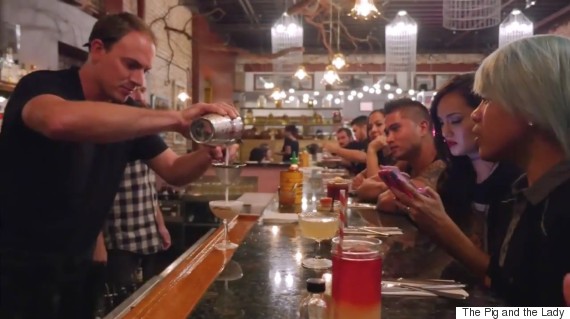
The Pig and the Lady offers rich flavors in its food, but Kyle Reutner's bar has balanced cocktails to match. The Matchbox, for instance, mixes local Kohana Agricole Rum, Dolin Blanc Vermouth, a little dry Curaçao with a splash of house-made grenadine and a few dashes of Mai Tai Bitters from the Hawaii Bitters Co.. It's all strained over one large ice cube. To finish it off, Reutner sets an orange peel aflame over the top of the cocktail.
Old Meets New At Bevy
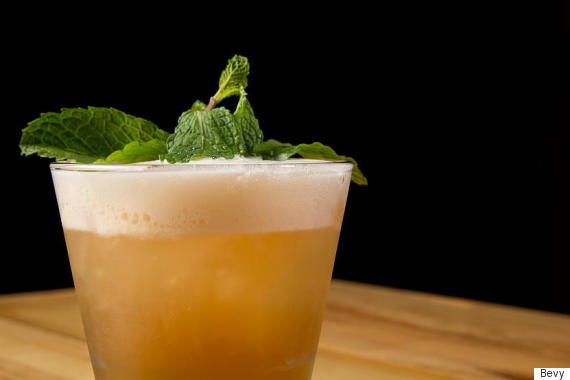
Christian Self's Bevy, in the developing Honolulu neighborhood of Kakaako, blends old-style cocktails with new technology. (Think the classic mai tai with a candied ginger foam.)
Newman's favorite is the Hall Pass: Rye whiskey, amaro, fresh lemon juice, a touch of sugar, egg white and lilikoi (passion fruit). Shaking the ingredients “vigorously together,” Newman says, “makes this one of the easier cocktails to drink.”
Playing With Emotions At Pint and Jigger
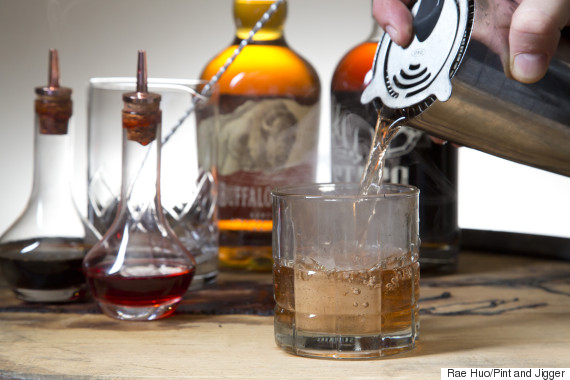
Pint and Jigger is all about the experience. Take their Mesquite Smoked Manhattan, for example. It all starts by mixing Buffalo Trace with Carpano Antica (an Italian Sweet Vermouth) and two types of bitters.
"Then we capture the smoke from torched mesquite chips under an Old Fashioned glass," Newman says. "Pouring the cocktail over a large format ice cube and into the smoke filled glass, it takes on this amazing smokey flavor. The only way I can describe it is that it really feels like you are drinking next to a campfire."
East-West Genius At Lucky Belly
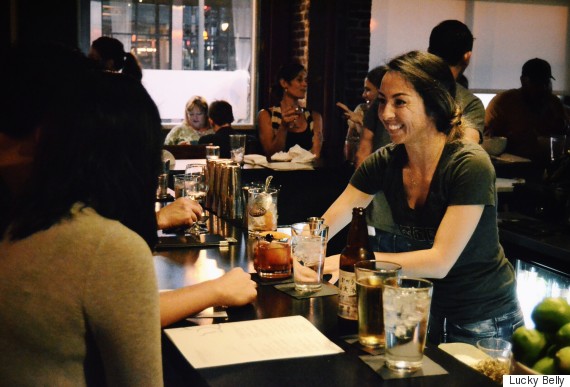
"This downtown haunt is known primarily for its great dining options," according to Newman, "but many people don't realize that they make some mean cocktails as well. The Bean to Box, created by Chris Nassar, is quickly becoming my go-to libation."
Infuse Akashi (a Japanese white oak whisky) with notes of vanilla and combine with Suze (a French brand of bitters), Luxardo Maraschino liquer, a splash of simple syrup and a dash of orange bitters. Finish with an orange twist.
Everyone Knows Your Name At Murphy's

According to Newman and Reutner, Murphy’s Bar and Grill in Chinatown is the place to go for ambiance and hospitality.
“First and foremost, Murphy’s is one of the most welcoming bars on the island,” Newman says. “I bring out of town guests here and they instantly feel at home. [Bartenders] Jonathan Schwalbenitz and Chad Pata have been holding it down behind that bar longer than most of us have been old enough to drink.”
Reutner says he feels like Murphy’s is his bar. “At Murphy’s, I get to watch my favorite bartenders treat everyone like a regular... Jon and Chad are the quintessential barmen.”
Newman says he gets an Irish coffee “made right with a generous portion of Irish whiskey and just the right amount of house-made whip cream,” while Reutner gets a shot of Ferenet and a beer. Simple, sure, but in Hawaii, a good bar is about the aloha spirit as much as the drinks.
True Tiki Style At La Mariana

If you want to see a bit of old Hawaii, Self recommends taking a trip to La Mariana Sailing Club, one of the last authentic tiki bars still around today.
In the middle of an industrial district known as Sand Island, near Honolulu airport, La Mariana sits on a boat harbor and is filled with decor from the old Waikiki mainstays Trader Vic’s and Don the Beachcomber.
“Grab a Zombie or a Tropical Itch, complete with back scratcher," Self says, "and hope you are there when the aunties come in and play old Hawaiian music -- you’ll really feel the aloha.”
Guilty Pleasures At Duke's Waikiki
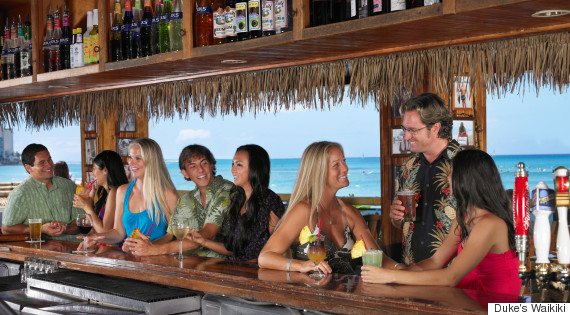
Self says visiting fellow bartenders Jesse and Amy Greenleaf at Duke’s bar in Waikiki is one of his guilty pleasures.
Recently ranked the No. 1 most Instagrammed restaurant in Hawaii, Duke's is perfectly situated to enjoy the sunset, the frequent fireworks in Waikiki and some classically delicious drinks with your toes in the sand.
“Grab a tropical concoction and sit beach side on the famous Waikiki beach, listen to live music and people-watch till the sun goes down,” Self says.
The Greenleafs are known for their Hawaiian Island Iced Tea: equal parts vodka, gin, Malibu coconut rum, and banana liqueur, shaken with lilikoi juice and 7-Up and poured into a tall glass over ice. It's a yellow-hued sweet drink that will hit you hard after a day in the sun.
Speakeasy Charm At The Manifest
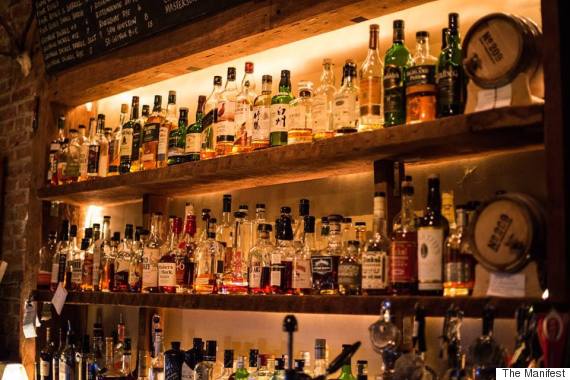
If you're in Chinatown, Reutner recommends the speakeasy vibe of The Manifest, which has a "slew of great bartenders." While the bar is mostly known for its carefully curated whiskey selection (including a bunch from Japan) and inventive cocktails, it also boasts a mean espresso bar and lively trivia nights.
Reutner's current go-to cocktail is currently the Movielife, a sophisticated take on tropical flavors. It's a combo of maraschino, gin, lemon, orange and kiawe pineapple bitters.
But Nothing Beats A Good View

If only someone would open a bar here. Reutner says that when he wants to check out and have a romantic drink with his girlfriend, “I'll snag a bottle of bubbles at Fujiokas Wine Times and hike the Makapuu tide pools with my beautiful woman. Truth is, it ain't legal [to drink there], but it's heaven.”
Want to read more from HuffPost Taste? Follow us on Twitter, Facebook, Pinterest and Tumblr.
But Honolulu -- the Aloha State's capital -- has a lot more to offer when it comes to challenging and impressing your tastebuds. Named the "next foodie frontier" by Condé Nast Traveler, the city is known for mixing eastern and western flavors as well as pushing the envelope when it comes to traditional tropical touches.
And the revolution doesn't stop at the fork.
As Dave Newman, owner and bartender of the Honolulu gastropub Pint and Jigger and president of the Hawaii chapter of the United States Bartenders Association, puts it: drinking around Honolulu has “certainly gotten much more interesting in the last few years.”
The Huffington Post wanted to know where the local experts go to drink in Honolulu, so we caught up with three of the city’s most successful bartenders -- Newman, Kyle Reutner of The Pig and the Lady, and Christian Self of Bevy -- to find out their favorite spots to imbibe.
Here are their top choices for both innovation and ambience, starting of course, with their own establishments:
Flavor Forward at The Pig and the Lady

The Pig and the Lady offers rich flavors in its food, but Kyle Reutner's bar has balanced cocktails to match. The Matchbox, for instance, mixes local Kohana Agricole Rum, Dolin Blanc Vermouth, a little dry Curaçao with a splash of house-made grenadine and a few dashes of Mai Tai Bitters from the Hawaii Bitters Co.. It's all strained over one large ice cube. To finish it off, Reutner sets an orange peel aflame over the top of the cocktail.
Old Meets New At Bevy

Christian Self's Bevy, in the developing Honolulu neighborhood of Kakaako, blends old-style cocktails with new technology. (Think the classic mai tai with a candied ginger foam.)
Newman's favorite is the Hall Pass: Rye whiskey, amaro, fresh lemon juice, a touch of sugar, egg white and lilikoi (passion fruit). Shaking the ingredients “vigorously together,” Newman says, “makes this one of the easier cocktails to drink.”
Playing With Emotions At Pint and Jigger

Pint and Jigger is all about the experience. Take their Mesquite Smoked Manhattan, for example. It all starts by mixing Buffalo Trace with Carpano Antica (an Italian Sweet Vermouth) and two types of bitters.
"Then we capture the smoke from torched mesquite chips under an Old Fashioned glass," Newman says. "Pouring the cocktail over a large format ice cube and into the smoke filled glass, it takes on this amazing smokey flavor. The only way I can describe it is that it really feels like you are drinking next to a campfire."
East-West Genius At Lucky Belly

"This downtown haunt is known primarily for its great dining options," according to Newman, "but many people don't realize that they make some mean cocktails as well. The Bean to Box, created by Chris Nassar, is quickly becoming my go-to libation."
Infuse Akashi (a Japanese white oak whisky) with notes of vanilla and combine with Suze (a French brand of bitters), Luxardo Maraschino liquer, a splash of simple syrup and a dash of orange bitters. Finish with an orange twist.
Everyone Knows Your Name At Murphy's

According to Newman and Reutner, Murphy’s Bar and Grill in Chinatown is the place to go for ambiance and hospitality.
“First and foremost, Murphy’s is one of the most welcoming bars on the island,” Newman says. “I bring out of town guests here and they instantly feel at home. [Bartenders] Jonathan Schwalbenitz and Chad Pata have been holding it down behind that bar longer than most of us have been old enough to drink.”
Reutner says he feels like Murphy’s is his bar. “At Murphy’s, I get to watch my favorite bartenders treat everyone like a regular... Jon and Chad are the quintessential barmen.”
Newman says he gets an Irish coffee “made right with a generous portion of Irish whiskey and just the right amount of house-made whip cream,” while Reutner gets a shot of Ferenet and a beer. Simple, sure, but in Hawaii, a good bar is about the aloha spirit as much as the drinks.
True Tiki Style At La Mariana

If you want to see a bit of old Hawaii, Self recommends taking a trip to La Mariana Sailing Club, one of the last authentic tiki bars still around today.
In the middle of an industrial district known as Sand Island, near Honolulu airport, La Mariana sits on a boat harbor and is filled with decor from the old Waikiki mainstays Trader Vic’s and Don the Beachcomber.
“Grab a Zombie or a Tropical Itch, complete with back scratcher," Self says, "and hope you are there when the aunties come in and play old Hawaiian music -- you’ll really feel the aloha.”
Guilty Pleasures At Duke's Waikiki

Self says visiting fellow bartenders Jesse and Amy Greenleaf at Duke’s bar in Waikiki is one of his guilty pleasures.
Recently ranked the No. 1 most Instagrammed restaurant in Hawaii, Duke's is perfectly situated to enjoy the sunset, the frequent fireworks in Waikiki and some classically delicious drinks with your toes in the sand.
“Grab a tropical concoction and sit beach side on the famous Waikiki beach, listen to live music and people-watch till the sun goes down,” Self says.
The Greenleafs are known for their Hawaiian Island Iced Tea: equal parts vodka, gin, Malibu coconut rum, and banana liqueur, shaken with lilikoi juice and 7-Up and poured into a tall glass over ice. It's a yellow-hued sweet drink that will hit you hard after a day in the sun.
Speakeasy Charm At The Manifest

If you're in Chinatown, Reutner recommends the speakeasy vibe of The Manifest, which has a "slew of great bartenders." While the bar is mostly known for its carefully curated whiskey selection (including a bunch from Japan) and inventive cocktails, it also boasts a mean espresso bar and lively trivia nights.
Reutner's current go-to cocktail is currently the Movielife, a sophisticated take on tropical flavors. It's a combo of maraschino, gin, lemon, orange and kiawe pineapple bitters.
But Nothing Beats A Good View

If only someone would open a bar here. Reutner says that when he wants to check out and have a romantic drink with his girlfriend, “I'll snag a bottle of bubbles at Fujiokas Wine Times and hike the Makapuu tide pools with my beautiful woman. Truth is, it ain't legal [to drink there], but it's heaven.”
Want to read more from HuffPost Taste? Follow us on Twitter, Facebook, Pinterest and Tumblr.
Discovering missing body parts of ancient fossils: Waves and storms lifted fossils off the seafloor 550 million years ago
Certain specimens of the fossil Dickinsonia are incomplete because ancient currents lifted them from the sea floor, a team of paleontologists has found. Sand then got deposited beneath the lifted portion, the researchers report, strongly suggesting that Dickinsonia was mobile, easily separated from the sea floor and not attached to the substrate on which it lived.
Parents Need Answers About Youth Sports Concussions
When 49ers inside linebacker Chris Borland announced his early retirement from the NFL after just one season, the league and fans reacted with shock. But as a father, a neuroscientist and a geriatrician, I can imagine all too well the immense relief that Borland's parents likely felt knowing they would no longer have to watch their son take a beating on Sunday afternoons.
My life's work is ending Alzheimer's disease and related dementias, the very things that Borland feared developing in his later life. I am deeply committed to strengthening our scientific understanding of the causes of dementia--including untangling the impact of sports-related childhood concussions (the sort that Borland suffered before entering the NFL) on later-life cognitive function.
As a parent, it wouldn't take much evidence for me to decide to keep my two now grown children out of high-impact sports like football and soccer. But as a scientist and a physician, I have a different perspective: I can see clearly just how much we still don't know--and how much we need to learn--to make well-founded, smart public health recommendations about childhood sports participation and concussion risks.
When it comes to adult traumatic brain injury and dementia risks, the evidence is more established. Last year, the NFL stated in federal court documents that it expects nearly a third of its retired players to develop long-term cognitive problems and predicted that the conditions are likely to emerge at "notably younger ages" than in the general population.
There's a key difference, though, between what we know about the link between adult traumatic brain injury and later life dementia, and what we know about childhood concussions and later life dementia. The truth is, we know very little about how childhood concussions influence the risk for dementia in adulthood. We need to accelerate this research so that parents and coaches can make better decisions about youth sport participation, practice policies and competition rules.
This month, I co-authored a consensus statement published in Nature Reviews Neurology about the need to advance research into the short-term and long-term neuropsychological outcomes of youth sports-related concussions. The statement was the result of a meeting convened by Safe Kids Worldwide, the Alzheimer's Drug Discovery Foundation and the Andrews Institute for Orthopaedics and Sports Medicine. The meeting brought together more than 25 experts in a variety of fields including neurology, sports injury reporting, ethics, genetics, biomarkers, dementia and neuroimaging. The group concluded that there is not enough evidence to establish a clear link between early-life repetitive head impacts and adult cognitive decline and dementia. This is contrasted by what is known about similar head impact injuries in adults and the established risk of later-life cognitive decline and dementia.
So how can we get answers about childhood concussions and late life dementia risks? We need to improve our understanding of the fundamental biology of concussions and how factors like age, sex and genetics influence concussion susceptibility and recovery. We need to support continued research and development of brain imaging techniques that shed light on the pathology of pediatric brain injury and have the potential to accelerate the development of novel therapies.
Moreover, we need to improve local and nationwide injury surveillance, eventually tracking youth athletes from the beginning of their athletic careers. According to the CDC, there were 250,000 nonfatal traumatic brain injuries recorded among individuals under the age of 19 in 2009, constituting 65 percent of all sports-related concussions. Many more may have incurred undiagnosed concussions and could suffer consequences in the future.
With better monitoring we can improve our understanding of the scope of the problem by conducting a large, long-term study following youth athletes across their athletic careers to determine the influence of repetitive head impacts on the risk of developing late-life cognitive decline and dementia.
The bottom line: we need to establish and encourage clear lines of research in many different but complementary fields to improve our knowledge and translate that data into actionable guidelines.
Chris Borland did not make his decision lightly, but he had the benefit of stronger research surrounding the link between adult concussions and dementia risk.
"The decision was simple after I had done a lot of research and it was personal," Borland said on "Face the Natioon" on Sunday, March 25. "I was concerned about neurological diseases down the road if I continued to play football.
It's not yet a simple decision for the parents of children playing high-impact sports. But with more research and better surveillance, we can ensure that parents, coaches, policymakers and physicians have the information they need to make educated decisions to protect the long-term health of young athletes.
My life's work is ending Alzheimer's disease and related dementias, the very things that Borland feared developing in his later life. I am deeply committed to strengthening our scientific understanding of the causes of dementia--including untangling the impact of sports-related childhood concussions (the sort that Borland suffered before entering the NFL) on later-life cognitive function.
As a parent, it wouldn't take much evidence for me to decide to keep my two now grown children out of high-impact sports like football and soccer. But as a scientist and a physician, I have a different perspective: I can see clearly just how much we still don't know--and how much we need to learn--to make well-founded, smart public health recommendations about childhood sports participation and concussion risks.
When it comes to adult traumatic brain injury and dementia risks, the evidence is more established. Last year, the NFL stated in federal court documents that it expects nearly a third of its retired players to develop long-term cognitive problems and predicted that the conditions are likely to emerge at "notably younger ages" than in the general population.
There's a key difference, though, between what we know about the link between adult traumatic brain injury and later life dementia, and what we know about childhood concussions and later life dementia. The truth is, we know very little about how childhood concussions influence the risk for dementia in adulthood. We need to accelerate this research so that parents and coaches can make better decisions about youth sport participation, practice policies and competition rules.
This month, I co-authored a consensus statement published in Nature Reviews Neurology about the need to advance research into the short-term and long-term neuropsychological outcomes of youth sports-related concussions. The statement was the result of a meeting convened by Safe Kids Worldwide, the Alzheimer's Drug Discovery Foundation and the Andrews Institute for Orthopaedics and Sports Medicine. The meeting brought together more than 25 experts in a variety of fields including neurology, sports injury reporting, ethics, genetics, biomarkers, dementia and neuroimaging. The group concluded that there is not enough evidence to establish a clear link between early-life repetitive head impacts and adult cognitive decline and dementia. This is contrasted by what is known about similar head impact injuries in adults and the established risk of later-life cognitive decline and dementia.
So how can we get answers about childhood concussions and late life dementia risks? We need to improve our understanding of the fundamental biology of concussions and how factors like age, sex and genetics influence concussion susceptibility and recovery. We need to support continued research and development of brain imaging techniques that shed light on the pathology of pediatric brain injury and have the potential to accelerate the development of novel therapies.
Moreover, we need to improve local and nationwide injury surveillance, eventually tracking youth athletes from the beginning of their athletic careers. According to the CDC, there were 250,000 nonfatal traumatic brain injuries recorded among individuals under the age of 19 in 2009, constituting 65 percent of all sports-related concussions. Many more may have incurred undiagnosed concussions and could suffer consequences in the future.
With better monitoring we can improve our understanding of the scope of the problem by conducting a large, long-term study following youth athletes across their athletic careers to determine the influence of repetitive head impacts on the risk of developing late-life cognitive decline and dementia.
The bottom line: we need to establish and encourage clear lines of research in many different but complementary fields to improve our knowledge and translate that data into actionable guidelines.
Chris Borland did not make his decision lightly, but he had the benefit of stronger research surrounding the link between adult concussions and dementia risk.
"The decision was simple after I had done a lot of research and it was personal," Borland said on "Face the Natioon" on Sunday, March 25. "I was concerned about neurological diseases down the road if I continued to play football.
It's not yet a simple decision for the parents of children playing high-impact sports. But with more research and better surveillance, we can ensure that parents, coaches, policymakers and physicians have the information they need to make educated decisions to protect the long-term health of young athletes.
Free breast cancer counselling – No fooling!
… , 2015
Free breast cancer
counselling – No fooling!
The NZ Breast Cancer
Foundation is today … breast cancer,”
said NZBCF chief executive Evangelia (Van) Henderson.
“Just as all breast cancers …
The NZBCF:
The New Zealand Breast Cancer
Foundation is a not-for-profit organisation …
Protein may improve liver regeneration: GF21 boosts regenerative ability in mice carrying human PPAR alpha protein
Researchers have illuminated an important distinction between mice and humans: how human livers heal. The difference centers on a protein called PPAR alpha which activates liver regeneration.
How My Husband Transformed My Son's MRI Scans Into Incredible Adventures
My son was 2 years old when he had his first MRI scan. After a long, painful night in the emergency room, a CT scan confirmed what we feared: Andrew had a tumor behind his left eye. An MRI was needed to get a clearer and more detailed picture of the horror we were facing.
On that first occasion, the MRI tech took him out of my arms and I listened to my son shriek my name over and over again with his arms flailing as he was carried down a very long, very white hallway. "Maaaama!! Maaaama!!! Mamaaaa!!!" Hearing his screams left me heartbroken and incredulous. It seemed like unnecessary trauma for a child who had already been through so much. Following his MRI and a biopsy, Andrew was diagnosed with Ewing's Sarcoma, a type of bone cancer.
The next time Andrew had a scan, my husband and I requested that we be allowed into the room with him until he fell asleep (from the anesthesia). The anesthesiologist looked at us skeptically, but he let us in. When we walked into the sterile room with the big whirring machine, I think we were all terrified. Andrew was afraid to lie down, and my husband and I were afraid of what the test would find. I was trying to convince Andrew to relax on the table by rubbing his head and telling him he was safe and would be OK. But it wasn't working.
And then my husband was inspired: "The mask is part of your spacesuit!" he told Andrew. "You need to breathe different air because you are going to a different atmosphere!" He told him that the MRI machine was a rocket ship, and he would be traveling to different planets and visiting funny aliens who told jokes. He told Andrew that he if he could be brave, he would get to see amazing things. The tension in the room disappeared. Everyone was smiling. Andrew decided he would wear the mask and be brave. He relaxed on the table, quickly fell asleep, and we left the room.
Since that time, Andrew has had at least 15 more MRIs. He currently returns every six months as part of his follow-up care. With each one, my husband tells a new story. "The mask smells stinky because you are going back in time to see dinosaurs! They fart A LOT! It's OK!" The MRI has doubled as a time machine, a rocket ship to circle the earth, a UFO to visit alien nations and even a brain transfer machine. Following one of his scans, the anesthesiologist returned to our room to tell us that Andrew had done well, and that it had been the smoothest parent involvement he had ever experienced.
Andrew turned 7 this year, and now actually looks forward to his MRIs. (I wish I could say the same.) A month ago, as I was tucking him into bed, he said, "I can't wait for my rocket ship ride so that I can come back and tell my friends what Jupiter and Venus look like!"
Andrew had his most recent MRI three weeks ago. It marked four years post-treatment. His trip into outer space was a success! My favorite part of the story: His tests were all clear.
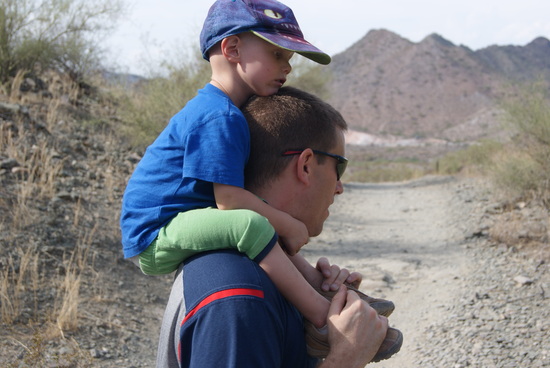
 Like Us On Facebook |
Like Us On Facebook |
 Follow Us On Twitter |
Follow Us On Twitter |
 Contact HuffPost Parents
Contact HuffPost Parents
On that first occasion, the MRI tech took him out of my arms and I listened to my son shriek my name over and over again with his arms flailing as he was carried down a very long, very white hallway. "Maaaama!! Maaaama!!! Mamaaaa!!!" Hearing his screams left me heartbroken and incredulous. It seemed like unnecessary trauma for a child who had already been through so much. Following his MRI and a biopsy, Andrew was diagnosed with Ewing's Sarcoma, a type of bone cancer.
The next time Andrew had a scan, my husband and I requested that we be allowed into the room with him until he fell asleep (from the anesthesia). The anesthesiologist looked at us skeptically, but he let us in. When we walked into the sterile room with the big whirring machine, I think we were all terrified. Andrew was afraid to lie down, and my husband and I were afraid of what the test would find. I was trying to convince Andrew to relax on the table by rubbing his head and telling him he was safe and would be OK. But it wasn't working.
And then my husband was inspired: "The mask is part of your spacesuit!" he told Andrew. "You need to breathe different air because you are going to a different atmosphere!" He told him that the MRI machine was a rocket ship, and he would be traveling to different planets and visiting funny aliens who told jokes. He told Andrew that he if he could be brave, he would get to see amazing things. The tension in the room disappeared. Everyone was smiling. Andrew decided he would wear the mask and be brave. He relaxed on the table, quickly fell asleep, and we left the room.
Since that time, Andrew has had at least 15 more MRIs. He currently returns every six months as part of his follow-up care. With each one, my husband tells a new story. "The mask smells stinky because you are going back in time to see dinosaurs! They fart A LOT! It's OK!" The MRI has doubled as a time machine, a rocket ship to circle the earth, a UFO to visit alien nations and even a brain transfer machine. Following one of his scans, the anesthesiologist returned to our room to tell us that Andrew had done well, and that it had been the smoothest parent involvement he had ever experienced.
Andrew turned 7 this year, and now actually looks forward to his MRIs. (I wish I could say the same.) A month ago, as I was tucking him into bed, he said, "I can't wait for my rocket ship ride so that I can come back and tell my friends what Jupiter and Venus look like!"
Andrew had his most recent MRI three weeks ago. It marked four years post-treatment. His trip into outer space was a success! My favorite part of the story: His tests were all clear.

 Like Us On Facebook |
Like Us On Facebook |  Follow Us On Twitter |
Follow Us On Twitter | Breast Cancer Survivors Relying on Beverly Hills Physicians to Help Them Reclaim Their Beauty
… 31, 2015 /PRNewswire/ -- For breast cancer patients, receiving word that their … – In many cases, when a breast cancer patient knows that she will … one in the fight against breast cancer, consider contacting Beverly Hills Physicians …
Skin tough: Why skin is resistant to tearing
Researchers have recorded the first direct observations of the micro-scale mechanisms behind the ability of skin to resist tearing. The results could be applied to the improvement of artificial skin, or to the development of thin film polymers for flexible electronics.
This Is Nursing
This is why I fell in love with my coworkers and with our nursing profession. I cannot look at this picture without getting a little teary. If you're religious, what religion you practice, whatever it is you may believe in... none of it matters. When we've had a horrific outcome, when we have had a close call, when one of our own is sick, we come together. We pray for our patients, we pray for their babies, we pray for our families, and we pray for our coworkers.
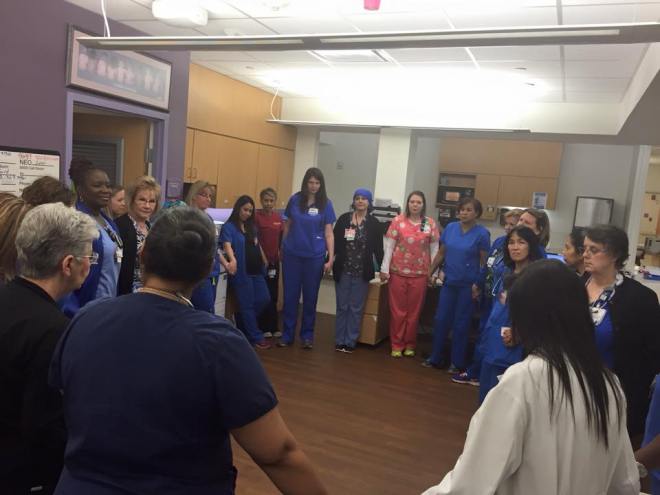 When times are tough. When times are rough.
When times are tough. When times are rough.
This is nursing. It's nurses, and physicians, and midwives, and unit clerks, and scrub techs, and patient care assistants and management, and even housekeepers! We are family. This is one of my work families, and I'm so proud to say that I work here, at Houston Methodist San Jacinto. Whatever our days bring, whatever walks through the door, we have each other. This isn't going on at just this hospital, in this city. This happens at every hospital, everywhere. I hope the people we serve know how we care for them, how we hurt for them. And I know how we care and hurt for each other. Sometimes we huddle together in the break room, sometimes we hug each other in an empty room. When we are blindsided by the unexpected or when our patients are blindsided, we cry together, we cry alone, and we cry at home. We're the only ones that know what kind of work we really do, and if we didn't have each other, it just wouldn't be nursing.
Like Adventures of a Labor Nurse on Facebook.
 When times are tough. When times are rough.
When times are tough. When times are rough.This is nursing. It's nurses, and physicians, and midwives, and unit clerks, and scrub techs, and patient care assistants and management, and even housekeepers! We are family. This is one of my work families, and I'm so proud to say that I work here, at Houston Methodist San Jacinto. Whatever our days bring, whatever walks through the door, we have each other. This isn't going on at just this hospital, in this city. This happens at every hospital, everywhere. I hope the people we serve know how we care for them, how we hurt for them. And I know how we care and hurt for each other. Sometimes we huddle together in the break room, sometimes we hug each other in an empty room. When we are blindsided by the unexpected or when our patients are blindsided, we cry together, we cry alone, and we cry at home. We're the only ones that know what kind of work we really do, and if we didn't have each other, it just wouldn't be nursing.
Until my next delivery ♥
Like Adventures of a Labor Nurse on Facebook.
Kids' Fast Food Consumption On The Decline

BY KATHRYN DOYLE
Mon Mar 30, 2015 1:57pm EDT
(Reuters Health) - Between 2003 and 2010, the number of U.S. kids eating fast food on any given day went down, and the calories from some types of fast foods have declined as well, according to a new study.
“Most prior studies have focused on menu items, but this (one) actually looked at what children are eating,” said coauthor Colin D. Rehm, formerly of the University of Washington in Seattle and now of Tufts University in Medford, Massachusetts.
“The take-home message is that changes can be made, whether they are due to consumer preference or due to what the restaurants have done themselves,” Rehm told Reuters Health by phone. “It shows that change is possible.”
According to data from the National Health and Nutrition Examination Surveys, in 2003, almost 39 percent of U.S. kids ate fast food on a given day, which dropped to less than 33 percent by the 2009-2010 survey.
Calorie intake from burger, pizza and chicken fast food restaurants also went down, while those from Mexican foods and sandwiches did not change.
Mexican food and sandwiches were minor contributors to total fast food consumption to start with, so it would have been difficult to detect a decrease over the course of the study, Rehm noted.
Other sources have noted a decline in pizza sales since 2003, which may explain some of the decrease in frequency and calories from those sources, the authors write in JAMA Pediatrics.
Increased consumer nutrition awareness and restaurant reformulations of menu items or portion downsizing also likely contributed to the trend, Rehm said.
“Menu labeling” with calorie information had really only just begun in 2010, so it would not have had a sizeable effect on these data, he said.
“Given that fast food intake appears to be declining among adults, it's not surprising that we'd see a similar trend in children,” said Katherine W. Bauer of the Center for Obesity Research and Education at Temple University in Philadelphia.
Bauer was not involved in the new study.
By 2010, fewer kids were visiting pizza restaurants every day, and when they did, they tended to consume fewer calories. For burgers, calories decreased but the percentage of visitors per day did not, indicating that kids, or their parents, started making lower-calorie choices at burger restaurants, Rehm said.
Reduced frequency of fast food intake and reduced caloric contributions from fast food are positive signs for health, Bauer told Reuters Health by email.
“From this paper alone I don't feel we're able to say that kids are getting healthier, because we don't know what, if anything, they're substituting for their fast food meals and snacks,” she said. “If children are substituting the calories from fast food for the same number of calories and quality of food from another type of restaurant, then they're no better off.”
This study only looked at calories and did not consider the nutrition profile of the foods, which is important, he noted. U.S. dietary goals should be to reduce calories and to improve the nutritional value of those calories, Rehm said.
“We're definitely getting a number of positive signs from around the country that our public health efforts to address obesity and improve children's nutrition may be working, including what we see in this paper,” Bauer said.
Other studies have noted a decrease in kids’ overall calorie consumption as well as added sugar consumption, Rehm said.
“There’s always room for improvement in the American diet, but we are seeing some encouraging results,” he said.
SOURCE: bit.ly/1adWrco JAMA Pediatrics, online March 30, 2015.
Study reveals high–cholesterol diet increases spread of prostate cancer
… diet increases the spread of prostate cancer tumours to lymph nodes, lungs and … of the original prostate cancer tumour, but the effect on cancer spreading was shown … improve prostate cancer survival?
More information: "Diet-induced hypercholesterolemia promotes androgen-independent prostate cancer metastasis …
Leeds woman’s drastic surgery step is hoped to prevent breast cancer fight
… has grown up surrounded by breast cancer. Her mother Shelley was first … . About five per cent of breast cancers are thought to be hereditary … breast cancer, sparking global media attention and a surge in referrals to breast cancer … yourself.”
For further information on breast cancer and Cancer Research UK’s …
For Your Liver's Sake, You Should Probably Keep Drinking Coffee
More than half of American grown-ups drink coffee every day. Their non-sipping counterparts may want to follow suit.
The health benefits associated with drinking coffee are plenty: The brew is packed with antioxidants and downing a cup can help wake up the brain and make a person feel more alert and focused. A new report published by the World Cancer Research Fund found that the apparently magical liquid can also decrease a person's risk for liver cancer.
The numbers are pretty significant: Researchers found that a consistent love for coffee could lower liver cancer risk by 14 percent. As part of ongoing research for the Continuous Update Project, a research team at Imperial College London analyzed 34 existing global studies about how diet, nutrition, physical activity and weigh relate to cancer risk and survival. Collectively, the studies covered approximately 8.2 million adults and 24,500 cases of liver cancer. Researchers are not sure why coffee might protect against the disease, but they hypothesized that certain compounds in the beverage could help to fight toxins. "Both coffee and coffee extracts have also been shown to reduce the expression of genes involved in inflammation, and the effects appear to be most pronounced in the liver," the report reads.
Researchers also found that those with an alcohol habit benefited from the addition a coffee habit: Those who consumed about three alcoholic beverages a day could reduce liver damage, ultimately lessening their risk for liver cancer.
H/T: Grub Street
The health benefits associated with drinking coffee are plenty: The brew is packed with antioxidants and downing a cup can help wake up the brain and make a person feel more alert and focused. A new report published by the World Cancer Research Fund found that the apparently magical liquid can also decrease a person's risk for liver cancer.
The numbers are pretty significant: Researchers found that a consistent love for coffee could lower liver cancer risk by 14 percent. As part of ongoing research for the Continuous Update Project, a research team at Imperial College London analyzed 34 existing global studies about how diet, nutrition, physical activity and weigh relate to cancer risk and survival. Collectively, the studies covered approximately 8.2 million adults and 24,500 cases of liver cancer. Researchers are not sure why coffee might protect against the disease, but they hypothesized that certain compounds in the beverage could help to fight toxins. "Both coffee and coffee extracts have also been shown to reduce the expression of genes involved in inflammation, and the effects appear to be most pronounced in the liver," the report reads.
Researchers also found that those with an alcohol habit benefited from the addition a coffee habit: Those who consumed about three alcoholic beverages a day could reduce liver damage, ultimately lessening their risk for liver cancer.
H/T: Grub Street
For Your Liver's Sake, You Should Probably Keep Drinking Coffee
More than half of American grown-ups drink coffee every day. Their non-sipping counterparts may want to follow suit.
The health benefits associated with drinking coffee are plenty: The brew is packed with antioxidants and downing a cup can help wake up the brain and make a person feel more alert and focused. A new report published by the World Cancer Research Fund found that the apparently magical liquid can also decrease a person's risk for liver cancer.
The numbers are pretty significant: Researchers found that a consistent love for coffee could lower liver cancer risk by 14 percent. As part of ongoing research for the Continuous Update Project, a research team at Imperial College London analyzed 34 existing global studies about how diet, nutrition, physical activity and weigh relate to cancer risk and survival. Collectively, the studies covered approximately 8.2 million adults and 24,500 cases of liver cancer. Researchers are not sure why coffee might protect against the disease, but they hypothesized that certain compounds in the beverage could help to fight toxins. "Both coffee and coffee extracts have also been shown to reduce the expression of genes involved in inflammation, and the effects appear to be most pronounced in the liver," the report reads.
Researchers also found that those with an alcohol habit benefited from the addition a coffee habit: Those who consumed about three alcoholic beverages a day could reduce liver damage, ultimately lessening their risk for liver cancer.
H/T: Grub Street
The health benefits associated with drinking coffee are plenty: The brew is packed with antioxidants and downing a cup can help wake up the brain and make a person feel more alert and focused. A new report published by the World Cancer Research Fund found that the apparently magical liquid can also decrease a person's risk for liver cancer.
The numbers are pretty significant: Researchers found that a consistent love for coffee could lower liver cancer risk by 14 percent. As part of ongoing research for the Continuous Update Project, a research team at Imperial College London analyzed 34 existing global studies about how diet, nutrition, physical activity and weigh relate to cancer risk and survival. Collectively, the studies covered approximately 8.2 million adults and 24,500 cases of liver cancer. Researchers are not sure why coffee might protect against the disease, but they hypothesized that certain compounds in the beverage could help to fight toxins. "Both coffee and coffee extracts have also been shown to reduce the expression of genes involved in inflammation, and the effects appear to be most pronounced in the liver," the report reads.
Researchers also found that those with an alcohol habit benefited from the addition a coffee habit: Those who consumed about three alcoholic beverages a day could reduce liver damage, ultimately lessening their risk for liver cancer.
H/T: Grub Street
Non-invasive technique allows amputee to use bionic hand, powered by his thoughts
Medical researchers have created an algorithm that allowed a man to grasp a bottle and other objects with a prosthetic hand, powered only by his thoughts.
Asbestos disease victim appeals to former Neston workmates
An ASBESTOS disease victim is appealing for information from … contacted the Merseyside Asbestos Victims Support Group and instructed industrial disease specialists Thompsons …
Research and Markets: Global Small Cell Lung Cancer Therapeutics Market 2015-2019
… and Markets: Global Small Cell Lung Cancer Therapeutics Market
2015-2019
Research and … the "Global
Small Cell Lung Cancer Therapeutics Market 2015-2019" report …
The report, Global Small Cell Lung Cancer Therapeutics Market 2015-2019,
has been …
Rounding Us Up, and Exposing Us All to Cancer
… ; levels of glyphosate contamination of numerous foods, … environmental toxins - lead, asbestos, radiation, PCBs, DDT, … Exposure to pesticides and the risk of childhood brain tumors. Cancer … ;Exposure to pesticides or solvents and risk of Parkinson disease…
Macrostructure of the universe: An 'unfocused' eye that sees the big picture
Designed to detect the fossil radiation of the Universe, the Planck satellite, working in tandem with Herschel, can also help to understand the macrostructure of the Universe. A just-published experimental study has detected astronomical sources that may be precursors to galaxy clusters, the largest dynamically stable structures existing in the Universe. These primitive elements have long been sought by astrophysicists since they are crucial for tracing the development of the Universe’s macrostructures. The classic methods used in the quest for large-scale structures are unfortunately difficult to apply (or just completely inapplicable to these objects).
Ancient cancer
… sign that cancer was a common ailment. After all, cancer is mainly … appeared to have had metastatic prostate cancer, which they published in PLoS … for a large proportion of tumours could be missed when skeletal … of developing cancer. Despite recent advances, the genetic background for cancer predisposition …
Presby University And Breast Care International Collaborate On Breast Cancer Awareness
… communities of the university on breast cancer issues.
The agreement expected to … in the interview during a breast cancer awareness programme organised by the … reduce breast cancer in the country.
‘’The incidence of breast cancer is … the students expressed interests in breast cancer given the magnitude of the …
Dunkin' Donuts Wants You To Eat Oreo Cheesecake Squares For Breakfast
Dunkin' Donuts is unveiling a new spring menu this April and it's definitely going to affect your summer beach body. That's because the company wants you to up your morning dessert game and try cheesecake for breakfast. Specifically, Dunkin' Donuts' new Oreo and Raspberry Cheesecake Squares -- because donuts alone weren't unhealthy enough.
Behold, the Squares in all their sugary glory:
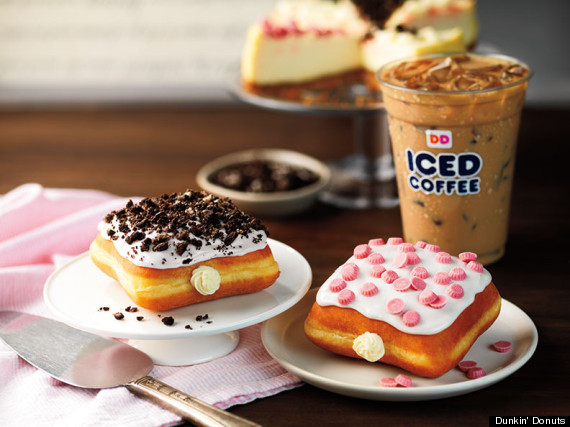
Available in April only, Dunkin' says these gluttonous stuffed donut squares are "filled with smooth and creamy cheesecake filling, frosted with white icing and finished with raspberry flavored candy or crumbled Oreo cookies."
The rest of Dunkin's new spring menu is surprisingly more savory than it is sweet. Possibly based on the company's success with its Tomato Mozzarella Supreme Bagel (or pizza bagel, as we like to call it), Dunkin' is trying out a Southwest Supreme Bagel. Described as "a plain bagel topped with melted Colby Jack cheese, corn, black beans, peppers, tomatoes, onions and spices," you can see it pictured below:

Other notable additions to the menu include a Snack 'N Go Steak Wrap and a Pretzel Roll Chicken Sandwich. The Pretzel Roll is breaded chicken with bacon, white cheddar cheese and honey mustard on a pretzel roll and seems like it could either be really good or really gross.

Want to read more from HuffPost Taste? Follow us on Twitter, Facebook, Pinterest and Tumblr.
Behold, the Squares in all their sugary glory:

Available in April only, Dunkin' says these gluttonous stuffed donut squares are "filled with smooth and creamy cheesecake filling, frosted with white icing and finished with raspberry flavored candy or crumbled Oreo cookies."
The rest of Dunkin's new spring menu is surprisingly more savory than it is sweet. Possibly based on the company's success with its Tomato Mozzarella Supreme Bagel (or pizza bagel, as we like to call it), Dunkin' is trying out a Southwest Supreme Bagel. Described as "a plain bagel topped with melted Colby Jack cheese, corn, black beans, peppers, tomatoes, onions and spices," you can see it pictured below:

Other notable additions to the menu include a Snack 'N Go Steak Wrap and a Pretzel Roll Chicken Sandwich. The Pretzel Roll is breaded chicken with bacon, white cheddar cheese and honey mustard on a pretzel roll and seems like it could either be really good or really gross.

Want to read more from HuffPost Taste? Follow us on Twitter, Facebook, Pinterest and Tumblr.
What's Up With All the Honking?
Recently I found myself in a new city. I won't mention it by name, but if you're curious I will say that it starts with an "F" and rhymes with "Mort Mauderdale."
Hubbie and I decided to spend our one day there checking out the sites. Our specific mission was to find a new pair of pajama pants (resulting from an unfortunate "I-can't-believe-you-forgot-to-check-that-drawer-before-we-checked-out" moment upon leaving our previous hotel).
The day was a hot one, as tends to happen in Mort Mauderdale. And we all know that the heat can take its toll on even the best of us.
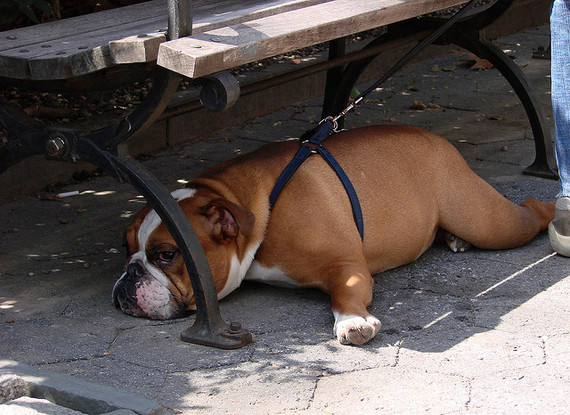
As we came to our first intersection, we watched as two cars turned in the same direction, attempting to merge into the same lane.
Both cars laid on the horn.
At the next block we saw the light turn green, and the lead driver was a bit slow to hit the gas. Which is apparently why the line of cars behind him...
...laid on the horn.
By intersection three we were curious. Would the trend continue? Sure enough, a car blocked the intersection while waiting for traffic to pass, causing a whole bunch of other cars to...
...lay on the horn.
We were puzzled. What was up with all that honking? And what did it say about the city of Mort Mauderdale?
And that's when we realized that the honking really had nothing to do with the city, or the heat, or even the cars that might have been at fault.
The honking had to do with the drivers who were doing it...the honkers if you will.
Now, to be fair I really can't judge too harshly on this one. I've certainly done my share of honking in this lifetime. Really, we all have.

But I also know what honking really is.
Honking is the opportunity to let someone know you're frustrated or angry, without ever having to face them in person. Honking is a form of passive aggression, and a somewhat cowardly one at that.
Honking is something that feels OK for many of us to do, but feels terribly personal when it happens to us.
Honking may create sound on the outside, but it happens because we're not too happy inside...and we need a release.
When you look at it this way, honking doesn't just happen in cars.
This kind of honking has nothing to do with those we're honking at...
...and everything to do with us as honkers.
What it really means is that we ourselves are frustrated or just feel bad in some way. It means that we are desperate to let off a bit of steam, to play the victim, to blame someone else for how we're feeling.
Sure, sometimes honking is necessary...like when a car drifts into our lane, or when a driver isn't paying attention. But we're not talking about that kind of honking.
We're talking about the bitter, laying-on-the-horn, passive-aggressive kind of honking.
The good news is that when we honk - inside the car or in another way - we've got a surefire sign that something is amiss in our lives. Which means we can then set about figuring out what it is and getting our lives back on track.
It's just up to us as honkers to take notice.
A few pointers for those on either side of the honking relationship...
To those who honk:
To those who get honked at:
I tried to remember this during that hot walk in Mort Mauderdale, and it worked. Because in that moment I was not in a honking place myself.
Nor was I later...when our mission was accomplished so successfully.
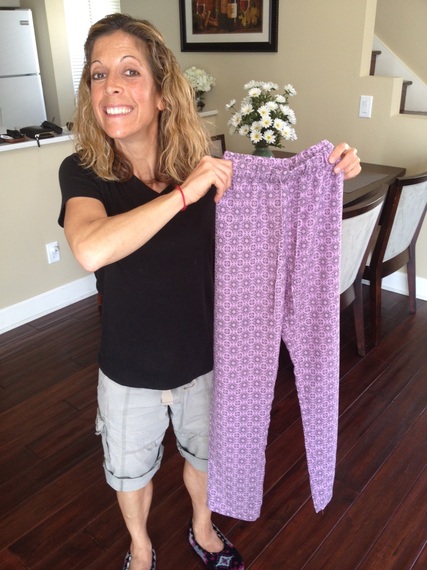
This week...
Recognize your honking tendencies - inside and outside of the car.
Figure out what's really up with your honking.
Then make it better. Honk less. Feel happier.
PS: Special thanks to humboldthead for the baby photo and istolethetv for the pooch pic.
Hubbie and I decided to spend our one day there checking out the sites. Our specific mission was to find a new pair of pajama pants (resulting from an unfortunate "I-can't-believe-you-forgot-to-check-that-drawer-before-we-checked-out" moment upon leaving our previous hotel).
The day was a hot one, as tends to happen in Mort Mauderdale. And we all know that the heat can take its toll on even the best of us.

As we came to our first intersection, we watched as two cars turned in the same direction, attempting to merge into the same lane.
Both cars laid on the horn.
At the next block we saw the light turn green, and the lead driver was a bit slow to hit the gas. Which is apparently why the line of cars behind him...
...laid on the horn.
By intersection three we were curious. Would the trend continue? Sure enough, a car blocked the intersection while waiting for traffic to pass, causing a whole bunch of other cars to...
...lay on the horn.
We were puzzled. What was up with all that honking? And what did it say about the city of Mort Mauderdale?
And that's when we realized that the honking really had nothing to do with the city, or the heat, or even the cars that might have been at fault.
The honking had to do with the drivers who were doing it...the honkers if you will.
Now, to be fair I really can't judge too harshly on this one. I've certainly done my share of honking in this lifetime. Really, we all have.

But I also know what honking really is.
Honking is the opportunity to let someone know you're frustrated or angry, without ever having to face them in person. Honking is a form of passive aggression, and a somewhat cowardly one at that.
Honking is something that feels OK for many of us to do, but feels terribly personal when it happens to us.
Honking may create sound on the outside, but it happens because we're not too happy inside...and we need a release.
When you look at it this way, honking doesn't just happen in cars.
- Honking happens in social media, when we post something nasty about a place of business or an elected official, knowing we'll never have to look them in the eye
- Honking happens when we shout nasty judgements at the celebrities or news reporters on our television sets, even though we don't know them at all
- Honking is the snarky comment we make about a co-worker under our breath...the passive aggressive dig we give to our sister...the rolling of the eyes when the store clerk isn't moving fast enough
This kind of honking has nothing to do with those we're honking at...
...and everything to do with us as honkers.
What it really means is that we ourselves are frustrated or just feel bad in some way. It means that we are desperate to let off a bit of steam, to play the victim, to blame someone else for how we're feeling.
Sure, sometimes honking is necessary...like when a car drifts into our lane, or when a driver isn't paying attention. But we're not talking about that kind of honking.
We're talking about the bitter, laying-on-the-horn, passive-aggressive kind of honking.
The good news is that when we honk - inside the car or in another way - we've got a surefire sign that something is amiss in our lives. Which means we can then set about figuring out what it is and getting our lives back on track.
It's just up to us as honkers to take notice.
A few pointers for those on either side of the honking relationship...
To those who honk:
- Recognize what it means when you lay on the horn
- Notice when you do it more, the patterns going on in your life
- Understand the real reason you're all honk-crazy
- Then try to make the problem better
To those who get honked at:
- Cut the driver some slack. He or she isn't in a good place. And you are. Because you're not honking.
- Try not to take it personally. Really, it's not about you. (Unless you drive really terribly. Then it might be a little bit.)
I tried to remember this during that hot walk in Mort Mauderdale, and it worked. Because in that moment I was not in a honking place myself.
Nor was I later...when our mission was accomplished so successfully.

This week...
Recognize your honking tendencies - inside and outside of the car.
Figure out what's really up with your honking.
Then make it better. Honk less. Feel happier.
PS: Special thanks to humboldthead for the baby photo and istolethetv for the pooch pic.
The Misunderstood March 31 FSA Run Out Deadline For Healthcare and Dependent Care Expenses
… roll over $500 of unused healthcare expenses into the new plan … account. (Credit: Getty Images)
Most healthcare FSAs still operate under the … accounts. Most employers—85%–offer healthcare FSAs, but only a fifth … is potentially worth double the healthcare break (there is no carry …
Ancient cancer
Ancient cancer 08:27 GMT As I rested on my couch last evening, laptop computer sitting in front of me, I awaited the Ken Burns adjustment of Siddartha Mukherjee’s exceptional book The Emperor of All Maladies into a three component television docudrama to air on PBS. I’m not sure whether I’ll [...] Read More
Convicted LeFlore County Killer Dies Of Lung Cancer
… probable cause of death was lung cancer.
Nichols was sentenced to life …
Monday, March 30, 2015
As stars form, magnetic fields influence regions big and small
Stars form when gravity pulls together material within giant clouds of gas and dust. But gravity isn't the only force at work. Both turbulence and magnetic fields battle gravity, either by stirring things up or by channeling and restricting gas flows, respectively. New research focusing on magnetic fields shows that they influence star formation on a variety of scales, from hundreds of light-years down to a fraction of a light-year.
The Best Vegetarian Option at 17 Fast-Food Chains
By: Rachel Freeman

Credit: Andy Kryza/Thrillist
It's hard out there for a vegetarian. Especially when it comes to snagging quick eats on the cheap. In a fast-food world where the burger reigns supreme and drive-thru menus tout vegetable sides inexplicably containing pork fat, options are, well, limited. But that doesn't mean it needs to all be doom and gloom -- all the major fast-food players have at least one tasty veg-friendly choice on their roster to keep you satisfied. And to save you from staring blankly at the drive-thru screen searching for something you can eat, we've rounded up the very best option at all the big chains.
Important note: many of the selections on this list are fried, which means there's no guarantee that they're not cooked in the same oil as non-veg items. If you're ordering at a fast-food spot, this is probably a risk you're already willing to take, but just know that if you are conscious of contamination, many of these suggestions will not work for you. You should probably just ask. Or just say "screw it," because you're starving.
More: Things People Say When You Tell Them You're a Vegetarian/Vegan
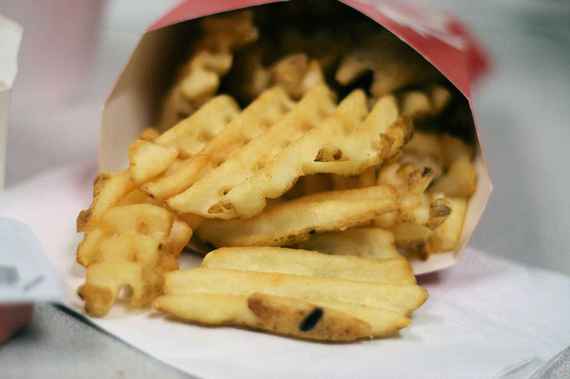
Credit: Flickr/Jay Reed
Chick-fil-A: Waffle fries
When a place is named after the animal it serves, you're kind of SOL. But since you're here (why are you here?!), the waffle fries are good. And they're allegedly vegan.
Carl's Jr./Hardee's: Veg It. Thickburgers
Both Carl's Jr. and Hardee's (Carl's Sr.?!) offer up a "Veg It." option for their Thickburgers. At Hardee's, that just means a burger, but minus the patty. At Carl's, though, they offer up a package of fried zucchini you can load onto the bun. Why they haven't seized the opportunity for a commercial featuring Paris Hilton washing a car while eating a zucchini is beyond us, but it seems like a missed opportunity for their campaign.
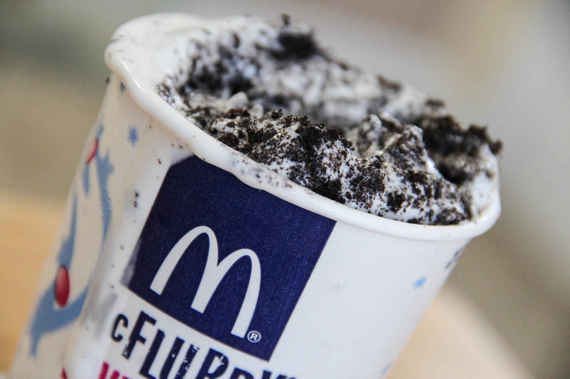
Credit: Aaron Miller/Thrillist
McDonald's: Oreo McFlurry
You might be tempted to go for the legendary fries at the Golden Arches, but turns out the oil they fry 'em in actually contains beef flavoring, so don't be fooled. Instead go for a creamy, cookie-filled McFlurry. When it's your tastiest option, no one can fault you for eating dessert for dinner. NO ONE.
Whataburger: Egg & cheese biscuit
Whataburger's biscuits are delicious on their own, and especially with honey butter. But that does not a balanced meal make. That's why the egg & cheese biscuit is king. And yes, it's still good with honey butter.
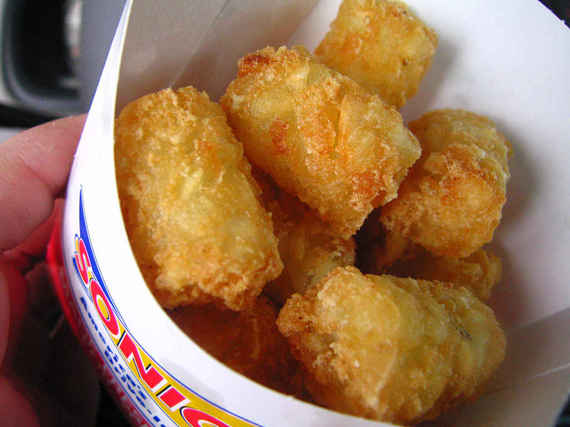
Credit: Flickr/Adam Kuban
Sonic: Cheese tots
Sonic is the only fast-food chain where it is imperative to forgo fries for an order of cheese sauce-covered tots instead. Golden and crispy on the outside, fluffy and starchy on the inside, these salty spuds are the spirit of Sonic and demand space in your stomach. Of course, you could choose to get them plain, but when melty cheese is a choice, there's really no choice at all.
Jack in the Box: Stuffed jalapeños
Jack's forte is 420-centric gigantic burgers, some of which are stuffed between grilled cheeses that aren't on the regular menu. Luckily, they have all-day breakfast, with egg sandwiches and mini pancakes. But let's be honest. If you're here, it's because you want something fried. So thank goodness for cheesy jalapeño poppers, which go pretty well with curly fries and a late-night viewing of The Wall.
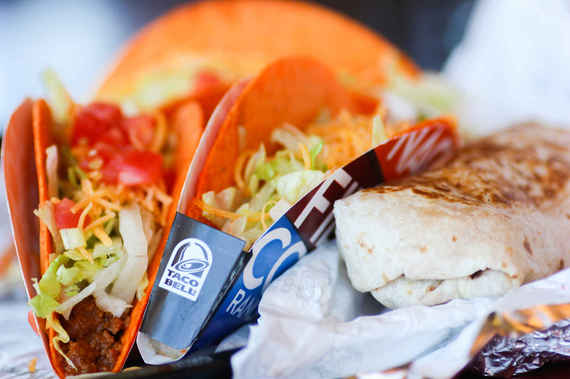
Credit: Lee Breslouer/Thrillist
Taco Bell: Anything and everything!
T-Bell is without a doubt the greatest fast-food spot for meatless folks, but that'll happen when your options are exactly the same as everyone else's. Pretty much everything at Taco Bell can be made meat-free with beans and/or potatoes as the replacement protein -- you just gotta ask. My personal favorites are the Crunchwrap, Cheesy Gordita Crunch, and Quesarito, but really, the world is your beefless burrito. Or whatever.
Arby's: Mozzarella sticks
What, you didn't know that Arby's has mozzarella sticks? Fair enough. It's hard to see past the Meat Mountain. But, as with any place that serves them, the mozz sticks at Arby's are insanely good -- as good as anything that you can get at a bar, but cheaper.
9 more of the best meatless fast-food options await, only at Thrillist.com!
More from Thrillist:
The 21 Best Vegetarian/Vegan Restaurants in America
Breaking Down the Single Best Item at Every Major Fast-Food Chain
Like Thrillist on Facebook: www.facebook.com/Thrillist

Credit: Andy Kryza/Thrillist
It's hard out there for a vegetarian. Especially when it comes to snagging quick eats on the cheap. In a fast-food world where the burger reigns supreme and drive-thru menus tout vegetable sides inexplicably containing pork fat, options are, well, limited. But that doesn't mean it needs to all be doom and gloom -- all the major fast-food players have at least one tasty veg-friendly choice on their roster to keep you satisfied. And to save you from staring blankly at the drive-thru screen searching for something you can eat, we've rounded up the very best option at all the big chains.
Important note: many of the selections on this list are fried, which means there's no guarantee that they're not cooked in the same oil as non-veg items. If you're ordering at a fast-food spot, this is probably a risk you're already willing to take, but just know that if you are conscious of contamination, many of these suggestions will not work for you. You should probably just ask. Or just say "screw it," because you're starving.
More: Things People Say When You Tell Them You're a Vegetarian/Vegan

Credit: Flickr/Jay Reed
Chick-fil-A: Waffle fries
When a place is named after the animal it serves, you're kind of SOL. But since you're here (why are you here?!), the waffle fries are good. And they're allegedly vegan.
Carl's Jr./Hardee's: Veg It. Thickburgers
Both Carl's Jr. and Hardee's (Carl's Sr.?!) offer up a "Veg It." option for their Thickburgers. At Hardee's, that just means a burger, but minus the patty. At Carl's, though, they offer up a package of fried zucchini you can load onto the bun. Why they haven't seized the opportunity for a commercial featuring Paris Hilton washing a car while eating a zucchini is beyond us, but it seems like a missed opportunity for their campaign.

Credit: Aaron Miller/Thrillist
McDonald's: Oreo McFlurry
You might be tempted to go for the legendary fries at the Golden Arches, but turns out the oil they fry 'em in actually contains beef flavoring, so don't be fooled. Instead go for a creamy, cookie-filled McFlurry. When it's your tastiest option, no one can fault you for eating dessert for dinner. NO ONE.
Whataburger: Egg & cheese biscuit
Whataburger's biscuits are delicious on their own, and especially with honey butter. But that does not a balanced meal make. That's why the egg & cheese biscuit is king. And yes, it's still good with honey butter.

Credit: Flickr/Adam Kuban
Sonic: Cheese tots
Sonic is the only fast-food chain where it is imperative to forgo fries for an order of cheese sauce-covered tots instead. Golden and crispy on the outside, fluffy and starchy on the inside, these salty spuds are the spirit of Sonic and demand space in your stomach. Of course, you could choose to get them plain, but when melty cheese is a choice, there's really no choice at all.
Jack in the Box: Stuffed jalapeños
Jack's forte is 420-centric gigantic burgers, some of which are stuffed between grilled cheeses that aren't on the regular menu. Luckily, they have all-day breakfast, with egg sandwiches and mini pancakes. But let's be honest. If you're here, it's because you want something fried. So thank goodness for cheesy jalapeño poppers, which go pretty well with curly fries and a late-night viewing of The Wall.

Credit: Lee Breslouer/Thrillist
Taco Bell: Anything and everything!
T-Bell is without a doubt the greatest fast-food spot for meatless folks, but that'll happen when your options are exactly the same as everyone else's. Pretty much everything at Taco Bell can be made meat-free with beans and/or potatoes as the replacement protein -- you just gotta ask. My personal favorites are the Crunchwrap, Cheesy Gordita Crunch, and Quesarito, but really, the world is your beefless burrito. Or whatever.
Arby's: Mozzarella sticks
What, you didn't know that Arby's has mozzarella sticks? Fair enough. It's hard to see past the Meat Mountain. But, as with any place that serves them, the mozz sticks at Arby's are insanely good -- as good as anything that you can get at a bar, but cheaper.
9 more of the best meatless fast-food options await, only at Thrillist.com!
More from Thrillist:
The 21 Best Vegetarian/Vegan Restaurants in America
Breaking Down the Single Best Item at Every Major Fast-Food Chain
Like Thrillist on Facebook: www.facebook.com/Thrillist
Suicide, Violence and Mental Illness

The story of 27-year-old Andreas Lubitz, co-pilot of Germanwings Flight #9525 who, reportedly, resolutely defied medical letters not to work because of illness and took 150 people, including himself, to a brutal end will surely ignite yet another round of confusion, consternation, and pitched comment about what to do:
- About the dangers posed by mental illness -- including the 40,000 suicides (and rising) annually in this country and the 22 American veterans who die at their own hands every day;
- About the horrific, episodic violent events that rock our minds and disrupt the peace of our families and communities, which include Adam Lanza (Newtown, Connecticut); James Holmes (Aurora, Colorado); Jared Loughner (Tucson, Arizona); Elliot Rodger (Santa Barbara, California); Seung-Hui Cho (Virginia Tech, Virginia); and Andreas Lubitz. What may seem like random acts of violence are not so random;
- About the inestimable and disproportionate human and economic toll taken by that very small percent of individuals whose serious mental illness impairs their capacity to recognize they are sick and to take steps to ensure their wellbeing and that of their communities.
I fear that Lubitz's story will unleash a fresh round of fear and vitriol regarding people with mental illness. I fear that simplistic reactions known not to work (like "lock them up and throw away the key") may again be seen as attractive answers to problems whose solutions can be understood but difficult to achieve. I fear that work towards protecting the public's safety will be lost in the fog of the war of words that are already descending upon us in the wake of this latest tragedy.
Andreas Lubitz does not fit the familiar profile of a person with serious mental illness who goes on to kill others and (typically) himself. Lubitz reportedly was not a loner, did not have a long history of isolation and alienation from family and friends, did not have an undetected mental illness (and he was presumably in treatment), and maintained at least a patina of competence and responsibility. As far as is known to date, he was not a terrorist. He apparently left no notes to explain his actions or take responsibility for the lives he took.
We thus face a different set of problems to tackle if we are to find direction from the wreckage of Flight #9525 and the fate of its passengers and their families.
I want to propose two paths for protecting the public as well as protecting people with serious mental illnesses. They call for real time performance information on those entrusted with our safety.
First, we need to revisit the limits of privacy, balancing both individual and community rights. Second, we need to consider measures that could reduce the risk of another deadly scenario, especially the potential for employing technological advances to identify problems before it is too late.
Privacy often takes the quality of a hallowed right, especially in this country. But privacy is not universal or unlimited. Privacy, particularly in mental health, can have both its needed place and its proper limits, especially when circumstances may be life-threatening. Those whose service involves our safety have that as their primary and overriding responsibility. Regular, random drug testing is a common example for many service employees whose work involves the health and safety of others.
Yet organizations whose employees are directly responsible for the public safety -- like doctors, police, firefighters, bus drivers, nurses, and pilots -- usually are not contacted when an employee is deemed medically not safe to work, as we painfully see with Germanwings (and Lufthansa). Has privacy trumped public safety? Would not the public safety be served if select groups of service workers with jobs that can impact safety and are in treatment for a medical condition (including psychiatric, neurological, and certain chronic illnesses that can impair cognitive functioning) consent to having their doctor report to their employer should they be determined unfit to work? Andreas Lubitz would not have flown that day were that the case. Impaired physicians and nurses would not endanger their patients were that the case. The right to return to work when fit would have to be guaranteed. Safety must always be the first priority, and the privilege of serving others should rest on that principle.
However, professions, mine included, do not have a stellar record of protecting those they serve. Do we have reason to believe that professional organizations or corporate entities can be trusted to protect their clientele? Self-interest, concerns about liability, and economic forces too commonly eclipse the integrity of purpose that is their mission.
R. Buckminster Fuller did not believe pressure could change people or organizations when he said, "You never change things by fighting the existing reality. To change something, build a new model that makes the existing model obsolete." We need something besides the imposition of external regulations and reporting requirements to achieve real and lasting change. Advances in technology and data systems may now allow for a new models of monitoring that heretofore were not possible.
We can, thus, today pursue a second, and parallel, path that adds clear measures to monitor all individuals with direct responsibility for others, such as the service personnel mentioned above and others whose work places the public safety in their hands. Here technology may offer feasible solutions that in the past were too intrusive and burdensome.
In NYC, for example, a combined multi-year effort by NYS and NYC monitored a very high-risk group of individuals with serious mental illness using administrative data to identify when they failed to attend their medical appointments or pick up prescribed medications, or had a sudden re-emergence of acute illness as evidence by ED or hospital admissions. This work focused on the clinical providers, not the patients, responsible -- where data alerted everyone involved about who was not doing well. Responsibility then lay with the provider organizations to act when patients were not succeeding. This initiative now is evolving into more accountable care organizations to ensure that those in trouble are reached and engaged.
This high risk initiative (or others like it) is, however, far too limited and focused on individuals with known histories of serious problems. That appears not to be the case for Lubitz or many others who have flown below the radar of responsible monitoring. What could work are real time measures of the performance of service personnel, agreed to by those given the privilege of bearing the responsibilities they do. Wearable devices far beyond Fitbit are emerging that can track and report changes in social behavior and functioning that correlate with impaired performance (often the result of illness) thereby alerting service organizations (as well as caregivers and health professionals) that a person's capacity to do his or her job may be compromised.
We don't want someone with a fever of 105 degrees operating heavy machinery or flying a NASA mission. We don't want someone whose cognitive capacities are transiently impacted by a mental (or other medical) illness or drug use driving our bus or operating on our abdomen. When someone is impaired, he or she needs to stand down, or not be allowed to work, until their functioning is again normal, as evidenced by real time performance measures. Perhaps a universal approach used for all workers the public relies upon for safety even could avoid the traps of diagnosis and stigma we see when a mental disorder limits functioning.
We need professions and service organizations to invite innovation from technology companies researching human performance measurement to build, test, and promote solutions that serve the public safety. We can find answers that balance individual liberties with collective needs, that prioritize safety, and that create the expectation that with certain privileges comes accountability for performance.
Regaining the public trust and professional pride are possible. But we will need a different glide path than that we have been on. We can use Flight #9525 as an impetus and a reminder that delays only invite yet another collective grave and failure of will when prevention could be possible.
The views expressed here are entirely my own. I take no support from any pharmaceutical or device company.
Dr. Sederer's book for families who have a member with a mental illness is The Family Guide to Mental Health Care (Foreword by Glenn Close) -- is now available in paperback.
If you -- or someone you know -- need help, please call 1-800-273-8255 for the National Suicide Prevention Lifeline. If you are outside of the U.S., please visit the International Association for Suicide Prevention for a database of international resources.
Cats relax to the sound of music
It is widely accepted that, in humans, music confers numerous benefits. An extensive body of research indicates that these benefits extend even to patients under general anesthesia, and include reduced perceived pain, anxiety and stress.
The Identified Patient
I met a woman in a bar. The place was nearly empty when she came in, sat down next to me and ordered a glass of wine. It was late afternoon and so was she -- a disheveled mass of silver and red hair bunned up with half a chopstick holding it all together. She was wearing a long, tye-died skirt, white sneakers and an over-sized grey sweatshirt with the words "ALL WOMAN" emblazoned across the front. Her glossy red lipstick was swiped across her lips in a way that smacked of I don't give a damn.
I knew what was coming, so I waited, staring steadfastly ahead, savoring my last sips of peace. After a few minutes, she turned toward me and began. "Hi I'm Annie. I just had to get out of the house. My son is driving me crazy, you know what I mean?" "Well, no," I said, "I'm not sure I do." She ignored that and went on with her soliloquy, throwing in the occasional, "you know what I mean." I got it. It was her way of taking a breath and so I stopped answering at all, simply nodding occasionally with a question mark of a face that said... no, not really.
Raymond
Apparently, her son Raymond, a 42-year-old software engineer, was depressed. His best friend had broken his heart, stolen a program they had developed together, sold it for big bucks and on his way out of town, had decided to take Raymond's girlfriend with him. "I told him," Annie said, "a million times, don't trust anyone, its the only way to protect yourself... they're all out to screw you... its the only way to keep your heart from being broken... you know what I mean?"
This time, I turned directly to her in a slow, emphatic voice: No, I'm not sure I do!" She backed up, exasperated at not having found a confederate and said, "you don't talk much, do you?" and walked out.
Multi-Generational Transmissions
From what I gathered of the situation, Raymond, taught early on that people and love were not to be trusted, but being the good son he was, spent half a lifetime finding folks that could prove the thoughts that his mother had planted in him.
Annie and Raymond's story is an example of how distorted, usually negative, thoughts and beliefs can be passed down in a multi-generational fashion from grandpa to mom to son and so on to form core beliefs and automatic thinking about people and the world in general.
Carl Jung said of it: "I feel very strongly that I am under the influence of things or questions which were left incomplete and unanswered by my parents and grandparents and more distant ancestors."(1).
In my practice I see it all the time, sometimes in adults; the dam bursts and they are flooded with a lifetime of contradictory thoughts and beliefs, desperate for their own truth, their authentic selves.
However, sometimes it happens early on in a child who senses that something is amiss in the collective family perception of the world. That child may become the identified patient, manifesting the very beliefs or behaviors he/she is so troubled by, or else behaving in a 180° contradiction to those sacred canons. It may be a heartfelt attempt to bring these dark conceptions into the light and restore a more reasonable, optimistic, civilized and elegant way of viewing the world.
These children are the lucky ones, resiliently bowed but unbroken. They can effect positive change early on and may be lifesavers for a whole family caught in a whirlpool of dysfunction.
For the rest of us, like Raymond, it may not be quite so easy. It can take tremendous courage and stamina to face our core beliefs and question their validity after a lifetime of unquestioned following. This warrior's quest towards authentic thought can also wreak havoc in a family system. For no matter how distorted or dysfunctional certain family beliefs and behavioral systems are, they may still be part of an integral fabric; the glue that holds a family together.
Which may be why we so often see when a family member changes his or her core beliefs, beliefs that go directly against the family system, that individual may have to leave the family for both to survive.
So, the next time your kid shows a prolonged manifestation of behavior you find particularly distressing, take a moment and go take a long look in the mirror.
And for Annie, whose Raymond is driving her crazy... you may have it upside down and backwards.
References
1. C. G. Jung, Memories, Dreams, Reflections (London 1983) p. 260
I knew what was coming, so I waited, staring steadfastly ahead, savoring my last sips of peace. After a few minutes, she turned toward me and began. "Hi I'm Annie. I just had to get out of the house. My son is driving me crazy, you know what I mean?" "Well, no," I said, "I'm not sure I do." She ignored that and went on with her soliloquy, throwing in the occasional, "you know what I mean." I got it. It was her way of taking a breath and so I stopped answering at all, simply nodding occasionally with a question mark of a face that said... no, not really.
Raymond
Apparently, her son Raymond, a 42-year-old software engineer, was depressed. His best friend had broken his heart, stolen a program they had developed together, sold it for big bucks and on his way out of town, had decided to take Raymond's girlfriend with him. "I told him," Annie said, "a million times, don't trust anyone, its the only way to protect yourself... they're all out to screw you... its the only way to keep your heart from being broken... you know what I mean?"
This time, I turned directly to her in a slow, emphatic voice: No, I'm not sure I do!" She backed up, exasperated at not having found a confederate and said, "you don't talk much, do you?" and walked out.
Multi-Generational Transmissions
From what I gathered of the situation, Raymond, taught early on that people and love were not to be trusted, but being the good son he was, spent half a lifetime finding folks that could prove the thoughts that his mother had planted in him.
Annie and Raymond's story is an example of how distorted, usually negative, thoughts and beliefs can be passed down in a multi-generational fashion from grandpa to mom to son and so on to form core beliefs and automatic thinking about people and the world in general.
Carl Jung said of it: "I feel very strongly that I am under the influence of things or questions which were left incomplete and unanswered by my parents and grandparents and more distant ancestors."(1).
In my practice I see it all the time, sometimes in adults; the dam bursts and they are flooded with a lifetime of contradictory thoughts and beliefs, desperate for their own truth, their authentic selves.
However, sometimes it happens early on in a child who senses that something is amiss in the collective family perception of the world. That child may become the identified patient, manifesting the very beliefs or behaviors he/she is so troubled by, or else behaving in a 180° contradiction to those sacred canons. It may be a heartfelt attempt to bring these dark conceptions into the light and restore a more reasonable, optimistic, civilized and elegant way of viewing the world.
These children are the lucky ones, resiliently bowed but unbroken. They can effect positive change early on and may be lifesavers for a whole family caught in a whirlpool of dysfunction.
For the rest of us, like Raymond, it may not be quite so easy. It can take tremendous courage and stamina to face our core beliefs and question their validity after a lifetime of unquestioned following. This warrior's quest towards authentic thought can also wreak havoc in a family system. For no matter how distorted or dysfunctional certain family beliefs and behavioral systems are, they may still be part of an integral fabric; the glue that holds a family together.
Which may be why we so often see when a family member changes his or her core beliefs, beliefs that go directly against the family system, that individual may have to leave the family for both to survive.
So, the next time your kid shows a prolonged manifestation of behavior you find particularly distressing, take a moment and go take a long look in the mirror.
And for Annie, whose Raymond is driving her crazy... you may have it upside down and backwards.
References
1. C. G. Jung, Memories, Dreams, Reflections (London 1983) p. 260
Streit's, America's Oldest Matzo Factory, Is Leaving New York's 'Jewish Plymouth Rock'
NEW YORK (AP) — The last ever Passover matzos have rolled out of a century-old bakery on Manhattan's Lower East Side — a neighborhood that's been dubbed the "Jewish Plymouth Rock" but is rapidly gentrifying.
The Streit's factory building is the oldest in the nation where the unleavened flatbread that's essential for Jewish holidays is still churned out. About 2.5 million pounds of matzos were baked for April's Passover holiday, and distributed worldwide.
Streit's is planning to shut down its nine-decade-old ovens by year's end and move to a 21st century computerized plant somewhere in the New York area. The contract has yet to be signed.
"For decades, immigrant Jews and their descendants have made 'pilgrimages' back to the Lower East Side — the Jewish Plymouth Rock — to reconnect with their history, and of course, delight in the shopping and eating that gives the neighborhood its flavor," said Annie Polland, a historian at the Lower East Side Tenement Museum. "With the Streit's closure, you have a significant chapter of Jewish Lower East Side history closing."
The bakery first opened during World War I, serving struggling Jewish immigrants. By 1925, the business moved to Rivington Street, where the original assembly line winds through four six-story buildings — once overcrowded tenements with narrow, rickety stairs that are still used.
But the 48,000-square-foot factory doesn't live off nostalgia. It's a smartly run family business with annual sales topping $20 million on about 5 million pounds of matzos sold around the country and worldwide.
The other mass manufacturer of matzos in the U.S. is Manischewitz, with Israeli imports and traditional round, handmade crackers also filling store shelves.
Demand is growing for matzos even among non-Jews who enjoy the healthy crackers baked with no fat or artificial additives, and the old factory simply cannot keep up, said Aaron Gross, head of sales and marketing at Streit's and one of three cousins running the day-to-day operations.
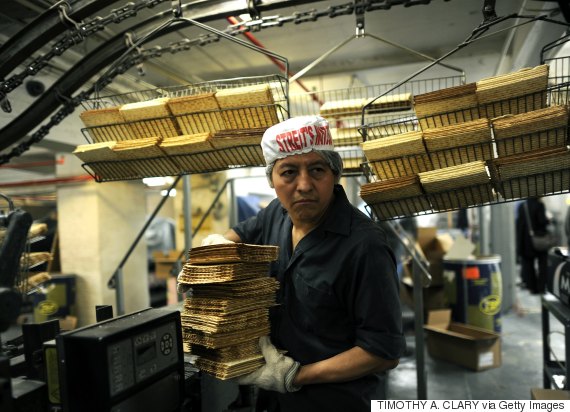
"I'm fifth generation, and if we want this to last another five generations, we need to make sure that we strengthen the company to remain relevant in a very competitive market," said Gross, the great-great-grandson of Aron Streit, who started the business after emigrating from Austria.
"The name Streit's conjures up so many happy memories of not only my childhood, but of the decades since," says Karen Kriendler Nelson, whose father and uncles were raised on the Lower East Side — an Austrian immigrant's sons running speakeasies, and eventually the famed uptown 21 Club restaurant.
The current Streit's production line dates back to the 1930s and the baking process is strictly timed.
It may take no more than 18 minutes from the moment the flour and water are mixed to when matzos emerge from a gas-fired, tunnel-like oven to cool in metal baskets hanging off rusty tracks inching slowly to the packaging operation. Beyond the 18 minutes, the dough rises — forbidden for this food that symbolizes the biblical flight of the Jews from Egypt, so rushed they had no time to finish baking this "bread of affliction."
"Nothing changes at Streit's," declared Rabbi Mayer Kirshner, who oversees the factory's kosher certification.
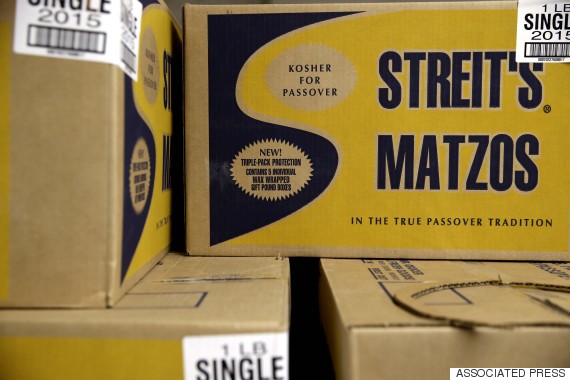
Some of the nearly 60 workers represent a recent wave of immigrants from former Soviet republics, like machine operator Michael Abramov who was born in Uzbekistan. He's been at Streit's for 25 years — the only job he's ever had in America.
"I'm not bored, I love this work; this is important, it's our religion, it's the history of the Jews," said the 61-year-old Queens resident.
Operations on Rivington Street will proceed until the new plant is up and running with state-of-the-art equipment that will speed up production.
These are not great-grandmother's matzos, kneaded and shaped by hand. Mass-produced and machine-packaged, they're a modern effort to preserve tradition. But tradition is quickly disappearing in the neighborhood that was home to Jewish immigrants for much of the 20th century. Property values have skyrocketed, with galleries, boutiques and restaurants opening in renovated tenements. The Streit's property — up for sale — is worth tens of millions of dollars.
The Streit's factory building is the oldest in the nation where the unleavened flatbread that's essential for Jewish holidays is still churned out. About 2.5 million pounds of matzos were baked for April's Passover holiday, and distributed worldwide.
Streit's is planning to shut down its nine-decade-old ovens by year's end and move to a 21st century computerized plant somewhere in the New York area. The contract has yet to be signed.
"For decades, immigrant Jews and their descendants have made 'pilgrimages' back to the Lower East Side — the Jewish Plymouth Rock — to reconnect with their history, and of course, delight in the shopping and eating that gives the neighborhood its flavor," said Annie Polland, a historian at the Lower East Side Tenement Museum. "With the Streit's closure, you have a significant chapter of Jewish Lower East Side history closing."
The bakery first opened during World War I, serving struggling Jewish immigrants. By 1925, the business moved to Rivington Street, where the original assembly line winds through four six-story buildings — once overcrowded tenements with narrow, rickety stairs that are still used.
But the 48,000-square-foot factory doesn't live off nostalgia. It's a smartly run family business with annual sales topping $20 million on about 5 million pounds of matzos sold around the country and worldwide.
The other mass manufacturer of matzos in the U.S. is Manischewitz, with Israeli imports and traditional round, handmade crackers also filling store shelves.
Demand is growing for matzos even among non-Jews who enjoy the healthy crackers baked with no fat or artificial additives, and the old factory simply cannot keep up, said Aaron Gross, head of sales and marketing at Streit's and one of three cousins running the day-to-day operations.

"I'm fifth generation, and if we want this to last another five generations, we need to make sure that we strengthen the company to remain relevant in a very competitive market," said Gross, the great-great-grandson of Aron Streit, who started the business after emigrating from Austria.
"The name Streit's conjures up so many happy memories of not only my childhood, but of the decades since," says Karen Kriendler Nelson, whose father and uncles were raised on the Lower East Side — an Austrian immigrant's sons running speakeasies, and eventually the famed uptown 21 Club restaurant.
The current Streit's production line dates back to the 1930s and the baking process is strictly timed.
It may take no more than 18 minutes from the moment the flour and water are mixed to when matzos emerge from a gas-fired, tunnel-like oven to cool in metal baskets hanging off rusty tracks inching slowly to the packaging operation. Beyond the 18 minutes, the dough rises — forbidden for this food that symbolizes the biblical flight of the Jews from Egypt, so rushed they had no time to finish baking this "bread of affliction."
"Nothing changes at Streit's," declared Rabbi Mayer Kirshner, who oversees the factory's kosher certification.

Some of the nearly 60 workers represent a recent wave of immigrants from former Soviet republics, like machine operator Michael Abramov who was born in Uzbekistan. He's been at Streit's for 25 years — the only job he's ever had in America.
"I'm not bored, I love this work; this is important, it's our religion, it's the history of the Jews," said the 61-year-old Queens resident.
Operations on Rivington Street will proceed until the new plant is up and running with state-of-the-art equipment that will speed up production.
These are not great-grandmother's matzos, kneaded and shaped by hand. Mass-produced and machine-packaged, they're a modern effort to preserve tradition. But tradition is quickly disappearing in the neighborhood that was home to Jewish immigrants for much of the 20th century. Property values have skyrocketed, with galleries, boutiques and restaurants opening in renovated tenements. The Streit's property — up for sale — is worth tens of millions of dollars.
Researchers develop new potential drug for rare leukemia
A new drug that shows potential in laboratory studies against a rare type of acute leukemia has been developed by scientists. And additional studies suggest the same compound could play a role in prostate cancer treatment as well, they say.
When to Stop Trying So Hard
We are taught that setting goals is a good thing. It helps us to be productive to have a specific, tangible achievement in mind with a rock solid end date. This is how we measure success. But when do we stop trying?
Setting goals gives us that kick in the butt that we often need to get moving because if we have a deadline, then we are committed and accountable.
Most of us are familiar with the idea that our goals need to be SMART goals.
But what if setting goals actually keeps us stuck rather than moves us forward? What if in setting SMART goals, we are actually neglecting the most important part of the process? Could this neglected part be the magic key that unlocks the door to a life of almost automatic continued achievement and happiness versus a life of striving, pushing, desperation, and force?
If this sounds at all intriguing, read on.
Why Do We Set Goals?
We set goals because we experience things in life that cause us to realize what we don't want, and ultimately, what we do want. This is called contrast. Contrast causes us to set goals all day every day. We do it without even consciously thinking about it.
We may not write them down, but our thoughts are constantly weeding through things that happen, making decisions on what we like and want more of, and what we dislike, and want less of.
We are taught that in order to achieve a goal, we must define it very clearly. This is where the idea of setting SMART goals comes into play.
We write down whatever it is that we want to achieve, because we believe that in achieving that goal, we will then be happy.
Then we take that a step further and we visualize it, we write affirmations about it, we lay out our plan on how we will get there, and then we get busy and wait for it to happen. How exciting... or not?
Have you ever set a goal, and you feel good at first, but then after a little while of it not happening, it becomes less of a motivator, and more of a, "Oh my gosh, I've got to make this happen or else" kind of feeling?
You know, that sick-to-your-stomach dread kind of feeling.
THIS is the key part of the process that is so often overlooked - the feeling that a goal creates inside of us.
When we think about a goal -- why we want it, when it will come, etc - the reason why so many people have trouble is because when they try to get specific about things they do not understand, they end up getting in their own way. They end up trying way too hard.
Here are seven things to remember when setting your next goal.
1. The art of allowing.
Goal setting is about having a clear understanding of what you want, and then allowing it to come into your life, not forcing it.
If a particular goal makes you feel good, then it's helpful and is the right approach, but if it just reminds you that something that you have been wanting for a long time hasn't happened yet, then it's keeping you stuck.
Define the goal in a way that makes you feel empowered rather than desperate. There is a big difference.
2. Taking action is only productive if it makes you feel good.
I know that it sounds hoakey, but it is ingrained in us so deeply that we've got to work hard and be determined and keep pushing and keep pushing if we want something to happen. This is not the case.
I tell you from personal experience that there has been so many times where I wanted something so badly that I pushed and pushed, like trying to move a giant boulder up a steep mountain.
It was so hard and took so much energy. This type of goal setting is exhausting, isn't it? There is a better way.
3. Focusing on a goal from a mindset of not having the goal, is contradictory.
This is the foundation of the phrase "trying too hard," which is a tough thing to wrap your head around, because the whole reason to set a goal is because we DON'T HAVE whatever it is that we want.
But I encourage you to take a step back from what you have been taught and hear me out.
When we focus on something that we want, and we have that feeling in the pit of our stomach that makes us acutely aware that we don't have it yet... that we are so far from where we want to be... that we are not good enough yet... that there are so many things that need to fall into place for what we want to achieve to actually happen... we are undermining our progress.
More than any other thing that we perceive as standing in our way, this is our biggest obstacle - WE are our own worst enemy!
Force negates.
4. Rather than thinking "it's not here yet," think "won't it be nice when..."
Say each of these phrases out loud. They feel very different, don't they? Granted we all have deadlines, commitments, and things that we have to do, that is part of life.
But how we think about our timeline is what matters most. If we are overwhelmed by feelings of anxiety as the time ticks by, we are screwing up our mojo.
5. Find a way to be satisfied with what is, while being eager for more.
If you set goals from a place of not having, and you keep feeling like you don't have it, you are holding yourself apart from allowing it to happen.
What is helpful is to think about the things that are going right. Focus the majority of your attention on those. We are so much more productive when we work from a place of inspiration than when we work from a place of tension.
6. Processes are good, but overdoing them isn't.
Processes are great tools, but when you take them to the extreme, they contradict their purpose. What matters most, above anything else, is how we feel when going through the process.
7. "Set it and forget it."
Ron Popeil really did know what he was talking about. Set a goal, know that the right circumstances will come into your life to allow it to happen... know that you will act from a place of inspiration and good feelings to allow it to happen... and then just let go.
Realize and accept that you don't have all the answers, nor do you have to.
How do we know the best way for us to get from point A to point Z? We are so busy pushing that rock up the mammoth mountain that we neglect to see that maybe there is a better way.
This is what I mean when I say that when we try to get specific about things we do not understand, we get in our own way. For most of us, this is both the most challenging and the most freeing task of all.
Just chill.
We are taught to be problem solvers. We could have nine things going right and one thing going wrong, and we choose to give that 1 thing our undivided attention.
Think about what happens when we do this. It slows everything down.
We are so scared to take our attention away from the things that are not going right because we are afraid that if we do, they will get worse rather than better.
Instead of spending all of your time and energy on the things that aren't working, just let them go. Stop putting emotion into the things you would previously worry about and instead focus your emotion on the things that are going right.
Reconnecting With Your Inner Voice
Try using these steps the next time contrast causes you to realize you want something more out of life.
Start listening to your inner voice, to your feelings. Paying more attention to your good feelings and less attention to your worries. Be determined to have fun and be happy rather than determined to "succeed," and I bet you will see that happiness brings success automatically.
Setting goals gives us that kick in the butt that we often need to get moving because if we have a deadline, then we are committed and accountable.
Most of us are familiar with the idea that our goals need to be SMART goals.
- Specific
- Measurable
- Attainable
- Realistic
- Timely
But what if setting goals actually keeps us stuck rather than moves us forward? What if in setting SMART goals, we are actually neglecting the most important part of the process? Could this neglected part be the magic key that unlocks the door to a life of almost automatic continued achievement and happiness versus a life of striving, pushing, desperation, and force?
If this sounds at all intriguing, read on.
Why Do We Set Goals?
We set goals because we experience things in life that cause us to realize what we don't want, and ultimately, what we do want. This is called contrast. Contrast causes us to set goals all day every day. We do it without even consciously thinking about it.
We may not write them down, but our thoughts are constantly weeding through things that happen, making decisions on what we like and want more of, and what we dislike, and want less of.
We are taught that in order to achieve a goal, we must define it very clearly. This is where the idea of setting SMART goals comes into play.
We write down whatever it is that we want to achieve, because we believe that in achieving that goal, we will then be happy.
Then we take that a step further and we visualize it, we write affirmations about it, we lay out our plan on how we will get there, and then we get busy and wait for it to happen. How exciting... or not?
Have you ever set a goal, and you feel good at first, but then after a little while of it not happening, it becomes less of a motivator, and more of a, "Oh my gosh, I've got to make this happen or else" kind of feeling?
You know, that sick-to-your-stomach dread kind of feeling.
THIS is the key part of the process that is so often overlooked - the feeling that a goal creates inside of us.
When we think about a goal -- why we want it, when it will come, etc - the reason why so many people have trouble is because when they try to get specific about things they do not understand, they end up getting in their own way. They end up trying way too hard.
Here are seven things to remember when setting your next goal.
1. The art of allowing.
Goal setting is about having a clear understanding of what you want, and then allowing it to come into your life, not forcing it.
If a particular goal makes you feel good, then it's helpful and is the right approach, but if it just reminds you that something that you have been wanting for a long time hasn't happened yet, then it's keeping you stuck.
Define the goal in a way that makes you feel empowered rather than desperate. There is a big difference.
2. Taking action is only productive if it makes you feel good.
I know that it sounds hoakey, but it is ingrained in us so deeply that we've got to work hard and be determined and keep pushing and keep pushing if we want something to happen. This is not the case.
I tell you from personal experience that there has been so many times where I wanted something so badly that I pushed and pushed, like trying to move a giant boulder up a steep mountain.
It was so hard and took so much energy. This type of goal setting is exhausting, isn't it? There is a better way.
3. Focusing on a goal from a mindset of not having the goal, is contradictory.
This is the foundation of the phrase "trying too hard," which is a tough thing to wrap your head around, because the whole reason to set a goal is because we DON'T HAVE whatever it is that we want.
But I encourage you to take a step back from what you have been taught and hear me out.
When we focus on something that we want, and we have that feeling in the pit of our stomach that makes us acutely aware that we don't have it yet... that we are so far from where we want to be... that we are not good enough yet... that there are so many things that need to fall into place for what we want to achieve to actually happen... we are undermining our progress.
More than any other thing that we perceive as standing in our way, this is our biggest obstacle - WE are our own worst enemy!
Force negates.
4. Rather than thinking "it's not here yet," think "won't it be nice when..."
Say each of these phrases out loud. They feel very different, don't they? Granted we all have deadlines, commitments, and things that we have to do, that is part of life.
But how we think about our timeline is what matters most. If we are overwhelmed by feelings of anxiety as the time ticks by, we are screwing up our mojo.
5. Find a way to be satisfied with what is, while being eager for more.
If you set goals from a place of not having, and you keep feeling like you don't have it, you are holding yourself apart from allowing it to happen.
What is helpful is to think about the things that are going right. Focus the majority of your attention on those. We are so much more productive when we work from a place of inspiration than when we work from a place of tension.
6. Processes are good, but overdoing them isn't.
Processes are great tools, but when you take them to the extreme, they contradict their purpose. What matters most, above anything else, is how we feel when going through the process.
7. "Set it and forget it."
Ron Popeil really did know what he was talking about. Set a goal, know that the right circumstances will come into your life to allow it to happen... know that you will act from a place of inspiration and good feelings to allow it to happen... and then just let go.
Realize and accept that you don't have all the answers, nor do you have to.
How do we know the best way for us to get from point A to point Z? We are so busy pushing that rock up the mammoth mountain that we neglect to see that maybe there is a better way.
This is what I mean when I say that when we try to get specific about things we do not understand, we get in our own way. For most of us, this is both the most challenging and the most freeing task of all.
Just chill.
We are taught to be problem solvers. We could have nine things going right and one thing going wrong, and we choose to give that 1 thing our undivided attention.
Think about what happens when we do this. It slows everything down.
We are so scared to take our attention away from the things that are not going right because we are afraid that if we do, they will get worse rather than better.
Instead of spending all of your time and energy on the things that aren't working, just let them go. Stop putting emotion into the things you would previously worry about and instead focus your emotion on the things that are going right.
Reconnecting With Your Inner Voice
Try using these steps the next time contrast causes you to realize you want something more out of life.
Start listening to your inner voice, to your feelings. Paying more attention to your good feelings and less attention to your worries. Be determined to have fun and be happy rather than determined to "succeed," and I bet you will see that happiness brings success automatically.
Research Debunks 'An Apple A Day Doesn't Keep The Doctor Away
CHICAGO (AP) — An apple a day doesn't necessarily keep the doctor away. That's according to proverb-busting research that found daily apple eaters had just as many doctor visits as those who ate fewer or no apples.
The findings don't mean apples aren't good for you but they do underscore that it takes more than just one kind of food to make a healthy diet and avoid illness.
About one-third of the adults studied said they had no more than one doctor visit in the previous year; the remainder reported at least two visits. A preliminary analysis found apple eaters had slightly fewer visits than apple avoiders — those who ate less than one daily or no apples. But that difference disappeared when the researchers considered weight, race, education, health insurance and other factors that can influence frequency of medical visits.
More about the study, published Monday in JAMA Internal Medicine:
STUDY DETAILS
The researchers looked at data on about 8,400 U.S. adults who took part in government health surveys in 2007-08 and 2009-10. The adults answered questionnaires that included queries about foods they'd eaten in the previous 24 hours and medical care in the past year. About 9 percent of adults studied ate the equivalent of at least one small apple daily. Those who ate less than that were considered apple shunners.
Apple eaters had more education and were less likely to smoke than apple shunners, and fewer of them were white. Apple eaters were slightly less likely to use prescription drugs, but the study lacks information on use of over-the-counter medication and alternative medicine.
STUDY LIMITATIONS
Adults' food choices in the previous 24 hours don't necessarily reflect usual eating habits. The study lacks information on other foods people ate and it isn't rigorous enough to determine whether people who choose to eat apples are healthier or unhealthier than those who don't. The reason for the reported doctor visits also isn't included in the study.
Lead author Matthew Davis, a health services researcher at the University of Michigan, said while the study questions the proverb, "to really disprove it, you would need a different study design."
HOW 'BOUT THEM APPLES?
Apples are a good source of vitamin C; one medium apple has about 100 calories and provides nearly 20 percent of the daily recommended amount of fiber. Apples also contain small amounts of vitamin A, calcium and iron.
The proverb is thought to have originated in Wales in the 1800s. Apples, which have a long shelf life, were likely one of the few fruits that were available throughout the year, said Alice Lichtenstein, a Tufts University professor of nutrition science and policy. She wasn't involved in the study.
Nutritionists generally agree that apples can be a good food choice. But, said Dr. Steven Zeisel, director of the University of North Carolina's Nutrition Research Institute, "One apple isn't going to be enough to make a difference unless it's part of a healthy food pattern."
___
Online:
JAMA Internal Medicine: http://jamaiunternalmedicine.com
USDA-apples: http://tinyurl.com/p5hpz6m
___
AP Medical Writer Lindsey Tanner can be reached at http://www.twitter.com/LindseyTanner
Copyright 2015 The Associated Press. All rights reserved. This material may not be published, broadcast, rewritten or redistributed.
The findings don't mean apples aren't good for you but they do underscore that it takes more than just one kind of food to make a healthy diet and avoid illness.
About one-third of the adults studied said they had no more than one doctor visit in the previous year; the remainder reported at least two visits. A preliminary analysis found apple eaters had slightly fewer visits than apple avoiders — those who ate less than one daily or no apples. But that difference disappeared when the researchers considered weight, race, education, health insurance and other factors that can influence frequency of medical visits.
More about the study, published Monday in JAMA Internal Medicine:
STUDY DETAILS
The researchers looked at data on about 8,400 U.S. adults who took part in government health surveys in 2007-08 and 2009-10. The adults answered questionnaires that included queries about foods they'd eaten in the previous 24 hours and medical care in the past year. About 9 percent of adults studied ate the equivalent of at least one small apple daily. Those who ate less than that were considered apple shunners.
Apple eaters had more education and were less likely to smoke than apple shunners, and fewer of them were white. Apple eaters were slightly less likely to use prescription drugs, but the study lacks information on use of over-the-counter medication and alternative medicine.
STUDY LIMITATIONS
Adults' food choices in the previous 24 hours don't necessarily reflect usual eating habits. The study lacks information on other foods people ate and it isn't rigorous enough to determine whether people who choose to eat apples are healthier or unhealthier than those who don't. The reason for the reported doctor visits also isn't included in the study.
Lead author Matthew Davis, a health services researcher at the University of Michigan, said while the study questions the proverb, "to really disprove it, you would need a different study design."
HOW 'BOUT THEM APPLES?
Apples are a good source of vitamin C; one medium apple has about 100 calories and provides nearly 20 percent of the daily recommended amount of fiber. Apples also contain small amounts of vitamin A, calcium and iron.
The proverb is thought to have originated in Wales in the 1800s. Apples, which have a long shelf life, were likely one of the few fruits that were available throughout the year, said Alice Lichtenstein, a Tufts University professor of nutrition science and policy. She wasn't involved in the study.
Nutritionists generally agree that apples can be a good food choice. But, said Dr. Steven Zeisel, director of the University of North Carolina's Nutrition Research Institute, "One apple isn't going to be enough to make a difference unless it's part of a healthy food pattern."
___
Online:
JAMA Internal Medicine: http://jamaiunternalmedicine.com
USDA-apples: http://tinyurl.com/p5hpz6m
___
AP Medical Writer Lindsey Tanner can be reached at http://www.twitter.com/LindseyTanner
Copyright 2015 The Associated Press. All rights reserved. This material may not be published, broadcast, rewritten or redistributed.
New technique to kill cancer showing promise
New method to kill cancer revealing guarantee 10:09 GMT Publisher’s Note: For more information on the Duke College polio trial or other brain cancer cells tests, go here or call 919-684-5301 The adhering to script is from “Killing Cancer” which aired on March 29, 2015. Scott Pelley is the contributor. [...] Read More
'Google Maps' for the body: A biomedical revolution
Scientists are using previously top-secret technology to zoom through the human body down to the level of a single cell. Scientists are also using cutting-edge microtome and MRI technology to examine how movement and weight bearing affects the movement of molecules within joints, exploring the relationship between blood, bone, lymphatics and muscle.
You Are Stronger Than You Think You Are
In the Marine Corps, they train us very hard to be tough, efficient and extremely resilient. Physical and mental fitness is a part of everything we do. And although I felt like I was in good shape when I started Officer Candidate School, I lost 20 pounds in 10 weeks and returned to Colorado a different person. If someone had described to me the workout regimens we would be doing there, I would have said there was no way I could do that.
And similarly, eight years ago I might not have thought it possible to carry 65 pounds of gear, two weapons and lots of ammunition, all in 100-degree weather in Iraq, and to conduct long patrols 4-5 hours long at a given stretch. But we are all stronger than we think we are, and can each do amazing things.

It is important to remember this when you are having a bad day, or a bad week, or a bad month, and you feel like your world is closing in on you. The bottom line is, if you dig deep, you will find resources you may not have known you had. We are all survivors. We have all overcome adversity of some sort. We have all had our share of battles. And we have all gotten smarter, stronger, braver and wiser from the struggles we've endured. Maybe not right away, and maybe not easily, but we've bounced back from hard times, and we've proven to ourselves that our spirit is stronger than anything that could threaten to break it.
The early reports about my injury were that I had been killed in action -- when Corpsman Grant turned me over after I was shot, he said that I wasn't breathing anymore. So, I know that life can be very difficult, and we all face challenges. But take it from me -- life is also sweet, precious and something we should treasure, not just get through. Life should be about celebration, jut simply survival.
So you need to turn challenges around and fight through them. I did, and each of you can too. Over the last eight years I have tried to lead from the front and serve as a role model to other wounded warriors. Not only does that ensure that I am pushing myself in the right direction, but it also motivates others around me. I imagine in your daily lives, at work and at home, there are plenty of opportunities for you to also lead from the front.

And similarly, eight years ago I might not have thought it possible to carry 65 pounds of gear, two weapons and lots of ammunition, all in 100-degree weather in Iraq, and to conduct long patrols 4-5 hours long at a given stretch. But we are all stronger than we think we are, and can each do amazing things.

It is important to remember this when you are having a bad day, or a bad week, or a bad month, and you feel like your world is closing in on you. The bottom line is, if you dig deep, you will find resources you may not have known you had. We are all survivors. We have all overcome adversity of some sort. We have all had our share of battles. And we have all gotten smarter, stronger, braver and wiser from the struggles we've endured. Maybe not right away, and maybe not easily, but we've bounced back from hard times, and we've proven to ourselves that our spirit is stronger than anything that could threaten to break it.
The early reports about my injury were that I had been killed in action -- when Corpsman Grant turned me over after I was shot, he said that I wasn't breathing anymore. So, I know that life can be very difficult, and we all face challenges. But take it from me -- life is also sweet, precious and something we should treasure, not just get through. Life should be about celebration, jut simply survival.
So you need to turn challenges around and fight through them. I did, and each of you can too. Over the last eight years I have tried to lead from the front and serve as a role model to other wounded warriors. Not only does that ensure that I am pushing myself in the right direction, but it also motivates others around me. I imagine in your daily lives, at work and at home, there are plenty of opportunities for you to also lead from the front.

Why You're Getting Bombarded With More Alcohol Ads Than Ever Before
Beer behemoths are on an advertising bender as craft brewers slurp up drinkers.
Spending on alcohol ads has shot up 400 percent over the last four decades, according to a new study from the University of Texas at Austin. Yet the amount of booze Americans are buying has remained relatively the same. Brands are fighting harder to keep drinkers, but they're not convincing them to drink more.
“It’s gotten harder and harder to reach consumers,” Gary B. Wilcox, the lead author of the study and a professor at the college’s advertising school, told The Huffington Post on Friday. “The size of the market isn’t expanding, so the intensity for market share has greatly increased over the last 40 years.”
The following chart shows how the average American's alcohol consumption has changed over the years:
Between 1971 and 2011, alcohol sales remained relatively anemic, the study found. In 2012, the average American drank about 24.5 gallons per person, up slightly from 22.2 gallons in 1971 but down from a 1982 peak of 28.8 gallons.
That starts to look pretty pitiful when you consider the recent intensity of the industry's ad spending. Alcohol purveyors have been buying up ad space on any available medium since 1971, the year the Federal Trade Commission lifted a ban on advertising booze via broadcast outlets. As more and more money has been sunk into ads, the amount of alcohol consumed hasn't changed all that much.
Here's an inflation-adjusted look at how the advertising for alcohol has skyrocketed:
Recently, global beer giants Anheuser-Busch InBev, SABMiller and Heineken have ramped up spending in the face of steeper competition from small-batch brewers, whose business depends more on concocting interesting flavors and less on marketing to a large audience.
“Consumers are switching from quantity to quality,” Nick Petrillo, alcohol industry analyst at the research firm IBISWorld, told HuffPost. “Whereas the very nature of these macrobrewers is to sell palatable, mild beer that generally everyone can agree with and enjoy and just sell as much as possible.”
According to the study, advertising sales for beer increased to 64 percent of the overall alcohol market in 2012, up from 47 percent in 1971.
But beer consumption has remained pretty flat, as demonstrated in the following chart:
In response to weak sales, big-label brewers have gobbled up microbreweries in a series of acquisitions. And in cases where smaller competitors can't be bought out, larger companies have opted to bash them instead.
During the last Super Bowl, Budweiser -- AB InBev’s crown jewel -- aired a commercial mocking craft beer enthusiasts, dismissively stating, “Let them sip their pumpkin-peach ale.” Ironically, just two weeks before the big game, AB InBev had acquired Seattle-based Elysian Brewing Company, which sells a pumpkin-peach ale called “Gourdia on My Mind.”
Asked whether, in its entire history, Elysian Brewing has ever spent money on advertising the ale, the brewery told HuffPost, “No, definitely not.”
Spending on alcohol ads has shot up 400 percent over the last four decades, according to a new study from the University of Texas at Austin. Yet the amount of booze Americans are buying has remained relatively the same. Brands are fighting harder to keep drinkers, but they're not convincing them to drink more.
“It’s gotten harder and harder to reach consumers,” Gary B. Wilcox, the lead author of the study and a professor at the college’s advertising school, told The Huffington Post on Friday. “The size of the market isn’t expanding, so the intensity for market share has greatly increased over the last 40 years.”
The following chart shows how the average American's alcohol consumption has changed over the years:
Between 1971 and 2011, alcohol sales remained relatively anemic, the study found. In 2012, the average American drank about 24.5 gallons per person, up slightly from 22.2 gallons in 1971 but down from a 1982 peak of 28.8 gallons.
That starts to look pretty pitiful when you consider the recent intensity of the industry's ad spending. Alcohol purveyors have been buying up ad space on any available medium since 1971, the year the Federal Trade Commission lifted a ban on advertising booze via broadcast outlets. As more and more money has been sunk into ads, the amount of alcohol consumed hasn't changed all that much.
Here's an inflation-adjusted look at how the advertising for alcohol has skyrocketed:
Recently, global beer giants Anheuser-Busch InBev, SABMiller and Heineken have ramped up spending in the face of steeper competition from small-batch brewers, whose business depends more on concocting interesting flavors and less on marketing to a large audience.
“Consumers are switching from quantity to quality,” Nick Petrillo, alcohol industry analyst at the research firm IBISWorld, told HuffPost. “Whereas the very nature of these macrobrewers is to sell palatable, mild beer that generally everyone can agree with and enjoy and just sell as much as possible.”
According to the study, advertising sales for beer increased to 64 percent of the overall alcohol market in 2012, up from 47 percent in 1971.
But beer consumption has remained pretty flat, as demonstrated in the following chart:
In response to weak sales, big-label brewers have gobbled up microbreweries in a series of acquisitions. And in cases where smaller competitors can't be bought out, larger companies have opted to bash them instead.
During the last Super Bowl, Budweiser -- AB InBev’s crown jewel -- aired a commercial mocking craft beer enthusiasts, dismissively stating, “Let them sip their pumpkin-peach ale.” Ironically, just two weeks before the big game, AB InBev had acquired Seattle-based Elysian Brewing Company, which sells a pumpkin-peach ale called “Gourdia on My Mind.”
Asked whether, in its entire history, Elysian Brewing has ever spent money on advertising the ale, the brewery told HuffPost, “No, definitely not.”
Asbestos Disease Awareness Organization (ADAO) Announces Unity and Remembrance Brunch Sunday, April 19
Asbestos Disease … asbestos disease prevention, treatment for mesothelioma
and other asbestos-caused diseases, and global ban asbestos … Asbestos Disease Awareness Organization
The Asbestos Disease Awareness Organization (ADAO) was founded by
asbestos victims …
6 Ways You're Healthier Than You Think
So you’re not "eating clean," training for a marathon or meditating before your restorative nap each day? Relax -- you still might be healthier than you think.
By Carlin Flora
1. You talk about whole foods more than you eat them, but you speak two languages.
Lifelong bilinguals are protected against the onset of dementia, compared with monolinguals.
2. You know the benefits of red wine, but you choose a bit of bubbly instead.

Not only is champagne usually lower in calories than red wine, it is also heart-healthy. Plus, a study from the U.K. found that sipping 2 to 3 glasses of champagne per week can improve memory and stave off brain disorders.
3. Your mom (or grandma) is still alive at 95, and she was no health nut.
Family studies have indicated that genetic factors account for around 20 to 30 percent of the variation in the adult lifespan. One gene that scientists have their eye on is APOB, a cholesterol transporter that helps carry "bad cholesterol" in the blood. You might have it!
And if you suspect you don’t, focus on the 70 percent, some of which is definitely within your control. Two words: Eat nuts!
4. You stay out too late, but you do have sex twice a week.

Sex on a regular basis improves the immune system. A study from Wilkes University, in Pennsylvania, found that college students who had sex once or twice a week had higher levels of a particular antibody compared with abstainers.
5. You don’t have a treadmill desk at the office, but you have the admiration and support of your coworkers
A 20-year study concluded that the risk of death was significantly lower for people who reported a high level of peer support on the job.
(Salary and job descriptions are important, of course, but if you don’t feel respected and bolstered by your colleagues, you might want to freshen up your résumé.)
6. You don't work out, but you do work that floss.

There’s a growing body of evidence that heart disease, clogged arteries and strokes might be linked to inflammation and infections that oral bacteria can cause.
 Like Us On Facebook |
Like Us On Facebook |
 Follow Us On Twitter
Follow Us On Twitter
By Carlin Flora
1. You talk about whole foods more than you eat them, but you speak two languages.
Lifelong bilinguals are protected against the onset of dementia, compared with monolinguals.
2. You know the benefits of red wine, but you choose a bit of bubbly instead.

Not only is champagne usually lower in calories than red wine, it is also heart-healthy. Plus, a study from the U.K. found that sipping 2 to 3 glasses of champagne per week can improve memory and stave off brain disorders.
3. Your mom (or grandma) is still alive at 95, and she was no health nut.
Family studies have indicated that genetic factors account for around 20 to 30 percent of the variation in the adult lifespan. One gene that scientists have their eye on is APOB, a cholesterol transporter that helps carry "bad cholesterol" in the blood. You might have it!
And if you suspect you don’t, focus on the 70 percent, some of which is definitely within your control. Two words: Eat nuts!
4. You stay out too late, but you do have sex twice a week.

Sex on a regular basis improves the immune system. A study from Wilkes University, in Pennsylvania, found that college students who had sex once or twice a week had higher levels of a particular antibody compared with abstainers.
5. You don’t have a treadmill desk at the office, but you have the admiration and support of your coworkers
A 20-year study concluded that the risk of death was significantly lower for people who reported a high level of peer support on the job.
(Salary and job descriptions are important, of course, but if you don’t feel respected and bolstered by your colleagues, you might want to freshen up your résumé.)
6. You don't work out, but you do work that floss.

There’s a growing body of evidence that heart disease, clogged arteries and strokes might be linked to inflammation and infections that oral bacteria can cause.
 Like Us On Facebook |
Like Us On Facebook |  Follow Us On Twitter
Follow Us On Twitter
Subscribe to:
Posts (Atom)
